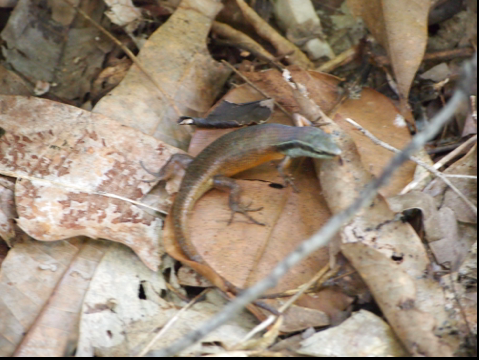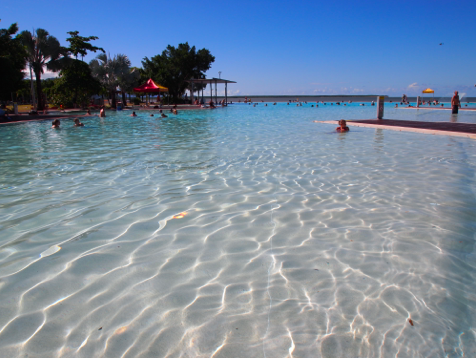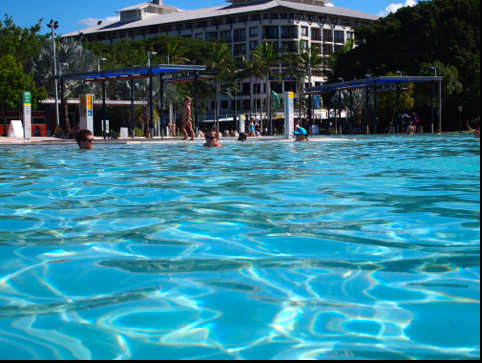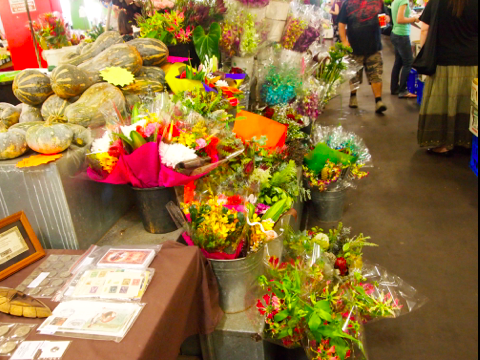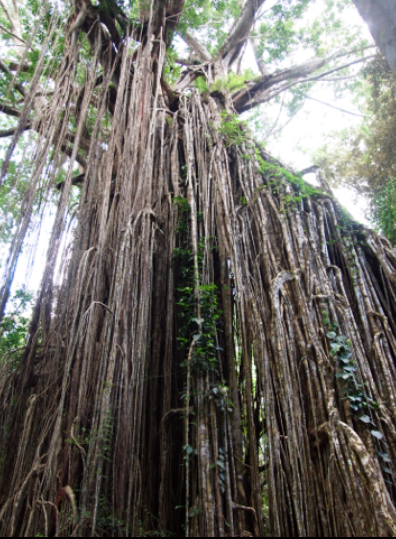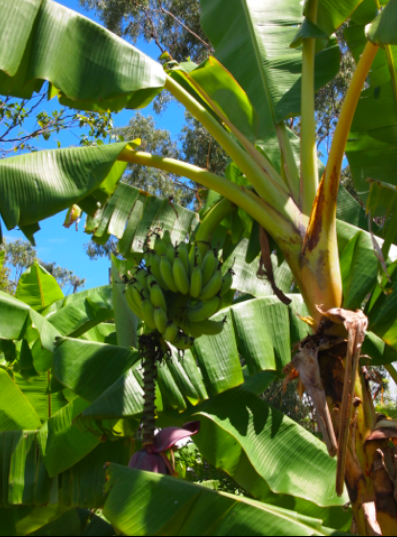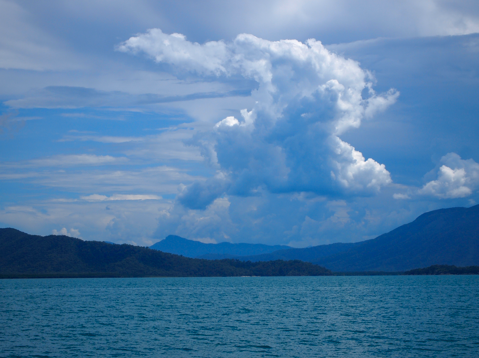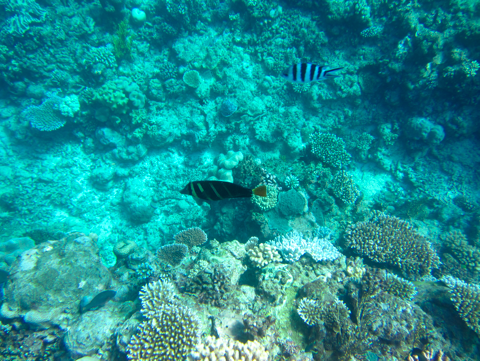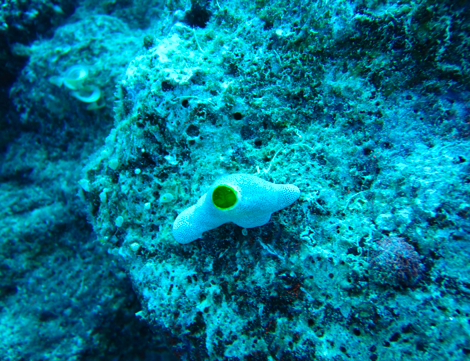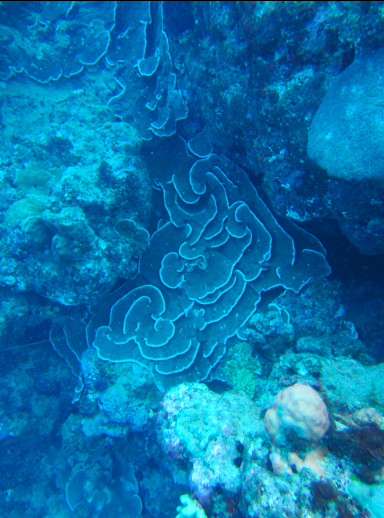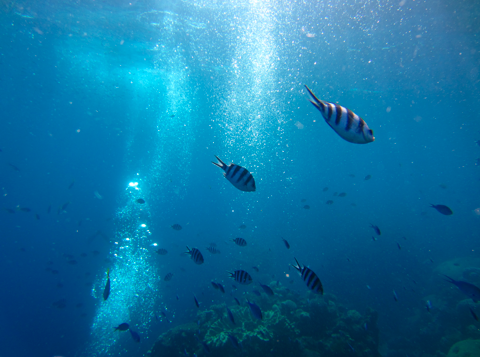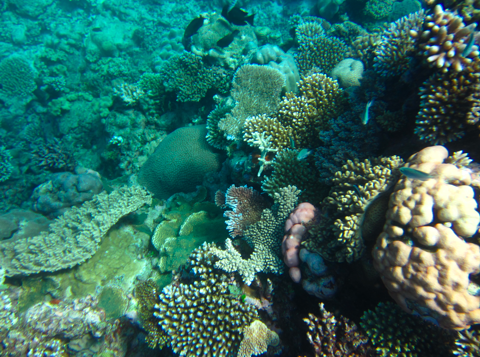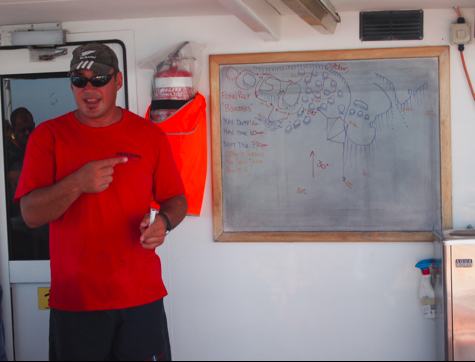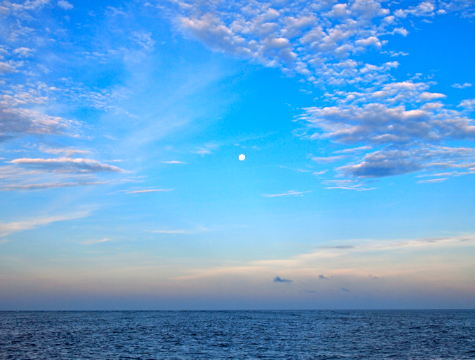Jack Erickson's Blog, page 7
May 7, 2012
Exotic wildlife on Fitzroy Island
Exotic wildlife on Fitzroy Island

Fitzroy Island goanna
During our two days on Fitzroy Island, we had several close encounters with local habitat. The island is a Queensland National Park with much of the area set aside as a refuge for flora, wild animals, birds, and insects with no impact from paved roads, residential development, industrial strips, or polluting industries. Step five meters into the jungle and you’re in dense foliage with little sign of human activities. Exciting, but potentially hazardous for urbanites. But who could resist not exploring the ‘wild side’ of the park.
Goanna
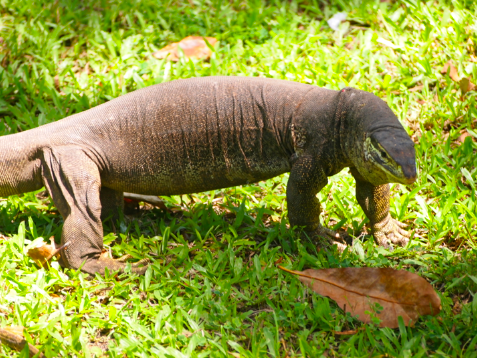
Carnivorous goanna
We’d arrived around 11 AM on the boat from Cairns and had to wait two hours before we could check in. No problem, we could explore a little of the island. We went to the beach and starting walking along a gravel path away from the resort. Within minutes, we had our first encounter with Fitzroy’s wildlife.
In a clearing designated as a picnic area with coconut palms, bougainvillea, and elephant ear palms, we spotted a reptile that looked like a large iguana. It was stationary in the grass, it’s long tail coiled, head erect like it was hunting a snake, rate, mole, or bird. The reptile was a goanna, an indigenous Australian monitor lizard that looks prehistoric, with dinosaur-like features, leathery scales, sharp claws, bony head and jaw, and beady yellow eyes.
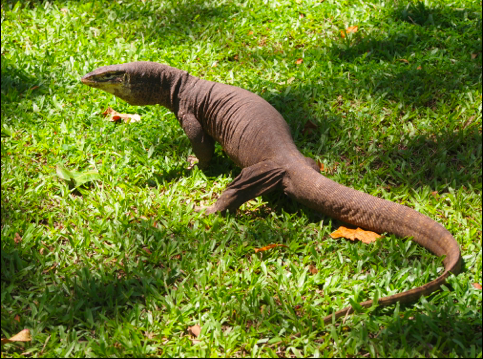
A possible house pet, would keep away rats, mice, and snakes
I wanted to photograph the goanna and study it up close. As I walked slowly towards it, the goanna remained stationary for a few seconds, then moved slowly in a circle, its tongue slithering out, as if parading to show off it’s ferocious appearance. It was the largest goanna we’d seen in Australia, about a meter long, a mature adult and experienced predator. Its muscular chest and legs looked ideal for chasing down prey in the jungle, climbing trees, digging in the dirt, or ambushing in the brush.
The goanna remained in the grass, watching us warily, but not fleeing into the jungle. After ten or fifteen minutes, we departed and left him in his territory. He had business to do, hunting prey or keeping other predators away.
Goanna in the morning
The next morning, the girls took a hike through the jungle to an abandoned lighthouse overlooking Little Fitzroy Island. I wanted to explore the island more, and headed down the same path to go deeper into the jungle. Passing by the picnic area, I walked along the perimeter where the grassy area met the jungle. Guess who I spotted — and almost stepped on. I jumped back and watched him. He didn’t move. Our goanna friend was well camouflaged in tall grass and brush and not moving to give away his position. Sign of a successful predator. He knew I’d eventually leave and he could get back to business.
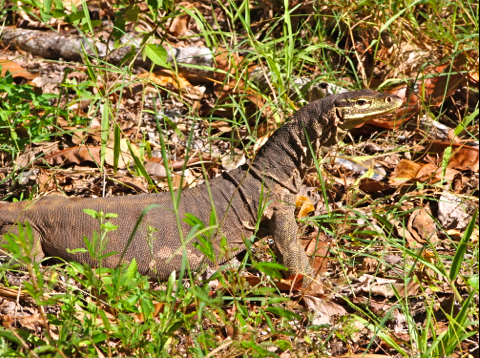
Camouflaged goanna
I was impressed with the goanna’s ability to remain stationary and by how well his coloring, mud-colored scaly skin that perfectly matched the weeds, grass, and dried leaves of the jungle floor.
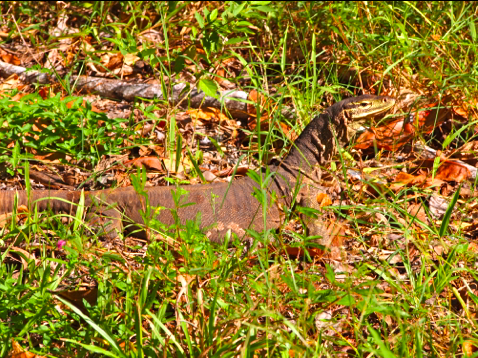
Almost stepped on goanna
I departed the goanna’s territory and continued walking along the path, deeper into the dense jungle, listening to insects chirping, birds cawing, and breeze fluttering the leaves. It was very quiet, but occasionally I’d hear a twig snap or dried leaves rustle. I’d stop and scan the foliage, seeing if I could spot a reptile, insects, or birds. I caught a glimpse of a flightless bird as it walked through the brush, but it was also well camouflaged and I couldn’t spot it long enough to get a good photo.
Slinky Skinks
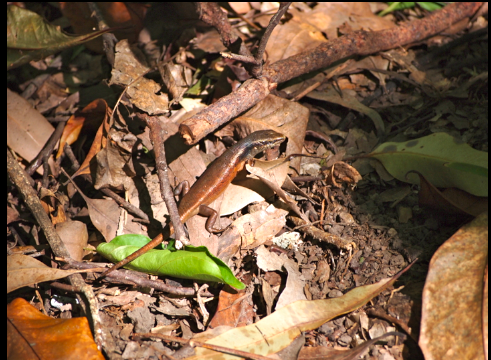
Fitzroy skink
Further down the trail, I saw a slight movement in some dry leaves and saw a small brown tail. Another reptile, a much smaller and almost slimy looking skink. It was only about six inches long and well camouflaged in mottled brown and green ground cover. Like the goanna, it remained still, possibly to detect sight or sound of an insect, or to evade being seen by larger predator.
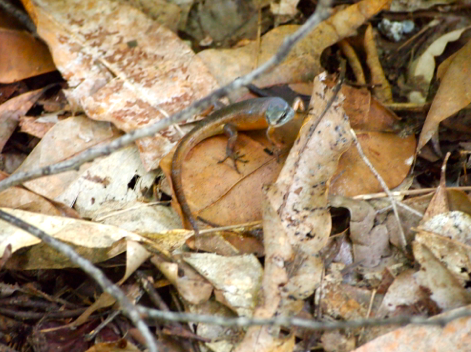
Camouflaged skink
“He’s back . . . “
Returning to the resort, I passed by the grassy picnic area to see if our old friend was still around. Sure enough, the goanna was prowling in his hunting territory, but this time in bright sunlight. He was fully exposed against the gravel and green grass, possibly getting warm in the sun. He certainly wasn’t afraid, he let me walk around, snapping photos until I got the one I wanted.
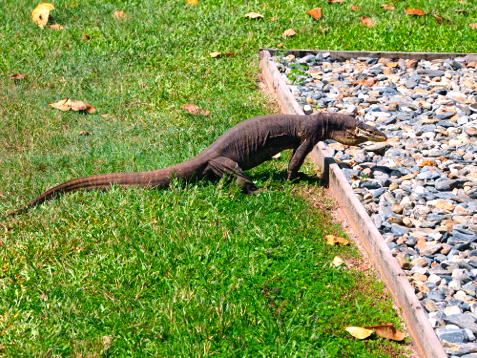
Once again, our goanna friend
I had seen him three times and watched his long forked tongue flick out from his mouth and back in, probably to sense danger or the scent of prey. His tongue flicked out about once every thirty seconds, but I missed several times, snapping just before or after he stuck it out. Finally after fifteen minutes of trying to time my shots, I finally got the picture I wanted.
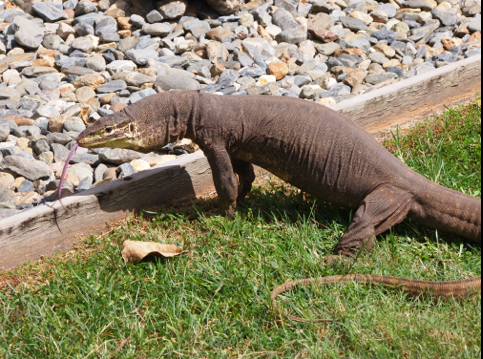
Finally – I caught the goanna’s slithering tongue
Noisy cockatoos
It was still morning and we had another hike to Nudey Beach after lunch. I left the path and walked along the beach, enjoying the sound of gentle waves lapping up from Welcome Bay. The beach was like Nudey with smooth shells and bleached coral, but with more driftwood, decayed leaves, fallen branches, and flotsam of a tropical island. During my walk in the jungle, I’d heard cockatoos noisily cawing in trees along the beach.
Cockatoos were perched in larger trees and well exposed on the end of long branches. I used a lens with a longer focal length and a got photos as they flew from tree to tree.

Cockatoo flying over Fitzroy beach
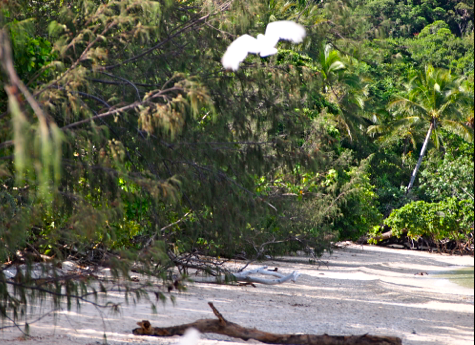
Fitzroy Cockatoo
Buick sized Spider
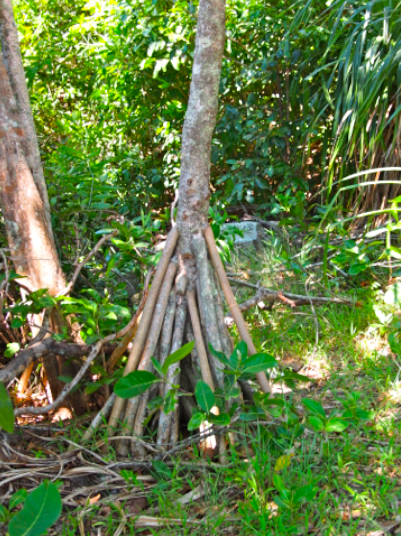
Mangrove tree at Nudey Beach
On our walk to Nudey beach around noon, we walked up and down boulders and stretches of rough gravel. Near the beach, we walked down a staircases. The first time on the stairs, I spotted a web that stretched almost across the staircase. It was almost invisible in the shade but I managed to stop before I walked into the web. I stepped back and saw one of the largest spiders I’d ever seen. I yelled out, “Wow, look at that, he’s the size of a Buick!” Well not quite, but when you’re surprised and see you’re inches from a huge spider, it affects your judgement a bit.
The spider was as long as a pen flashlight with six-inch legs that stretched over the web. He was a successful predator also, evidenced by the clumps of dead and dried insects snared in his web, evidence of past meals.
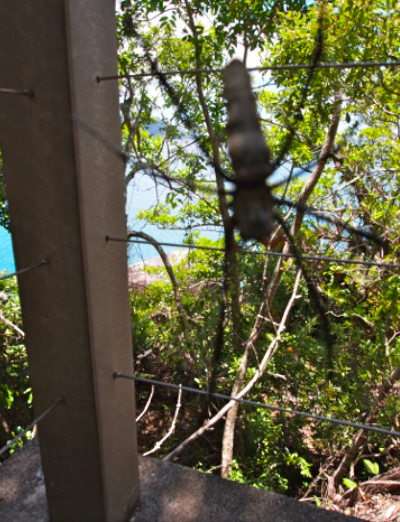
Giant spider on staircase to Nudey Beach
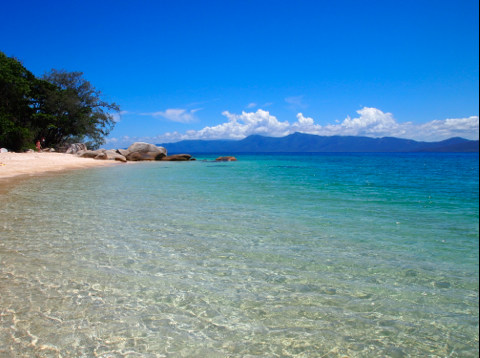
Second day at Nudey Beach
Fish feeding frenzy
Our last encounter with Fitzroy wildlife was on the wharf waiting for our ferry return to Cairns. We could see schools of fish on both sides, darting in the clear blue waters, larger on one side than the other. The smaller fish were actually a type of shrimp. They swirled in the water, moving in waves, like a flock of birds. Just as i started to take a video, the shrimp leapt out of the water and splashed back, once, twice, three times, making a noise like someone was churning the sea water.
“A manta ray just came it to feed on the shrimp,” a fellow said standing next to me at the railing. ”They wait until they school together, they sweep in and scoop them up in their mouth.” After the manta ray got a couple mouthful, the shrimp appeared more anxious, flitting in all directions, probably out of fear of being gobbled up.
On the other railing, larger fish were swimming under the wharf and around small boats. They looked to be two feet long, with sleek silver blue bodies and a forked tail. While a few of us were watching and commenting how sleek and pretty the fish were, a fellow came to the railing, reached into a yellow bucket and tossed a handful of grain into the water. It was like an explosion, the fish swarmed to the area, splashing and churning to feed on the drain.
“It’s 4 PM feeding time,” he said. The fellow comes from the resort restaurant to feed the fish every afternoon. ”That’s why there are so many fish here.” He identified them as swallow-tailed darts, a pretty but poor tasting fish. They only taste good to larger predator fish like sharks and eels.
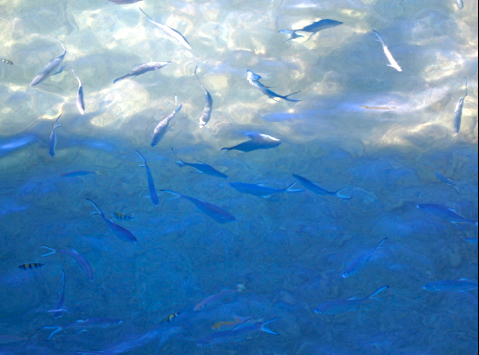
Swallow-tailed dart fish under Fitzroy ferry wharf
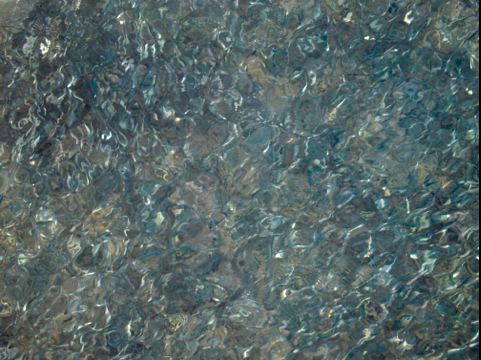
Shrimp agitated by feeding manta ray
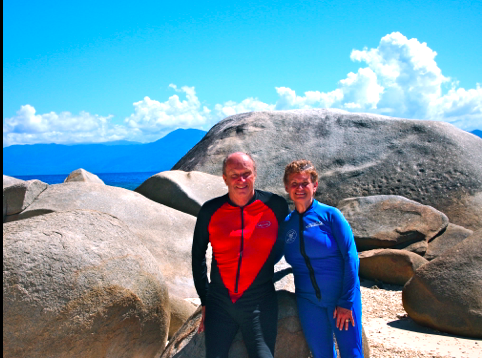
Good bye to Fitzroy — we’ll be back next year!
* * * * *
Next: New Zealand. We have many photos and exciting stories to share about our month in New Zealand. We traveled from Auckland on the northern island to the tip of the southern island with many adventures; hiking to glaciers and through rainforests, taking a wine country tour, seeing Maori ceremonies, and taking an overnight cruise in Fjordland National Park on the far southwest edge of the continent. Join us on A Year and a Day’s winter Down Under!
In addition to this travel blog, I also write mysteries and romantic suspense novels available on Kindle, Nook,
and Smashwords which distributes to ereader devices. I hope you’ll consider reading and reviewing them. I’ll be publishing a new murder
mystery, REX ROYALE, in a few weeks. Let me know if you’d like to read a preview of the opening chapters.
jacklerickson@gmail.com








May 4, 2012
Fitzroy Island
Fitzroy Island
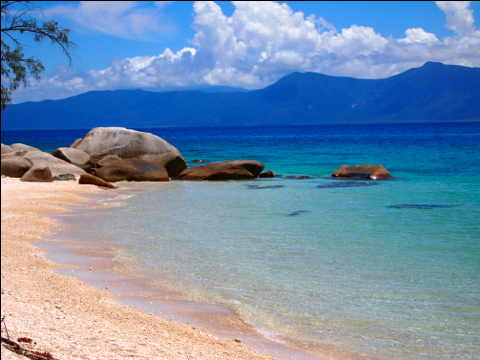
Fitzroy Island
Our last Great Barrier Reef adventure was spending two days on Fitzroy Island thirty kilometers from Cairns. We were blessed with another warm sunny day with puffy clouds over the mainland and Coral Sea when we boarded a ferry-boat for the hour trip over the deep blue sea.
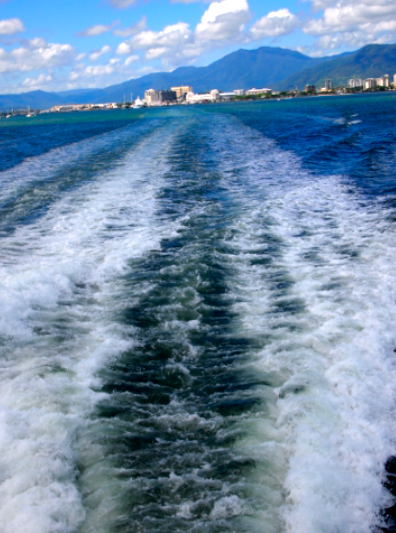
Sailing from Cairns to Fitrzoy Island
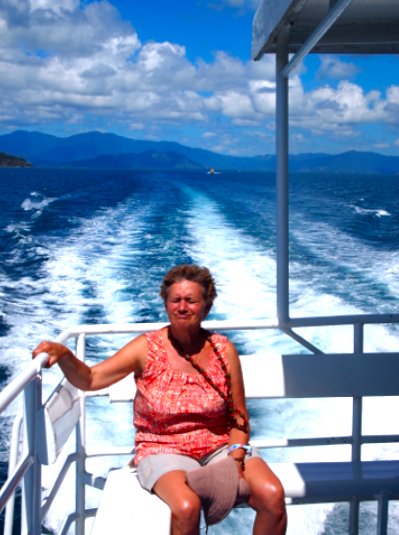
“I love the Great Barrier Reef!”
Fitzroy Island is a popular with day trippers who want to snorkel for the afternoon or tourists like us who want to spend a night or two at the resort and explore the idyllic setting. This allowed us to explore the island, hiking through tropical rainforest and to swim and snorkel on Nudey Beach. We managed to have several interesting experiences, enjoying the forest, seeing exotic animals and birds, and spend two afternoons on the nearly deserted beach to snorkel and swim in the warm waters.
Fitzroy resort
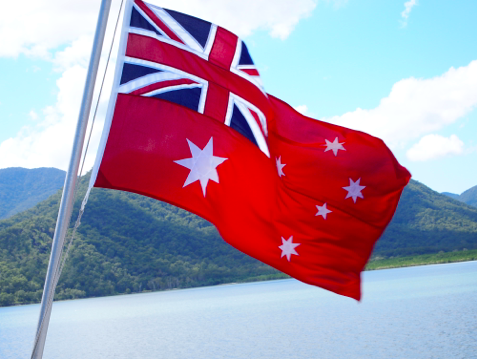
Australian flag with Southern Cross constellation
Fitzroy is a tropical paradise with modern resort with a pool, restaurants, gift shops, and even a theater for matinees and evening movies. Our room was on a second floor with a balcony looking over flowering tropical trees, a coral beach, and cove where yachts and sailboats were anchored. The views were almost idyllic with fragrance of flowers, palm trees, butterflies, and tropical birds.
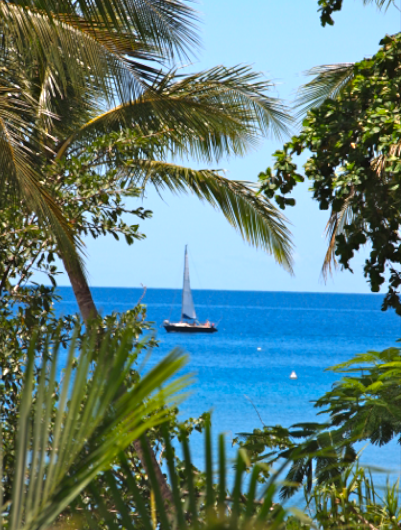
View from our second floor balcony
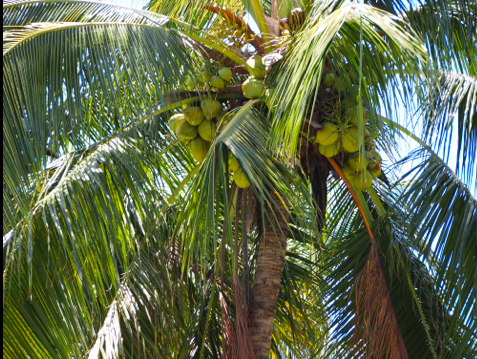
Coconut palm tree outside our balcony
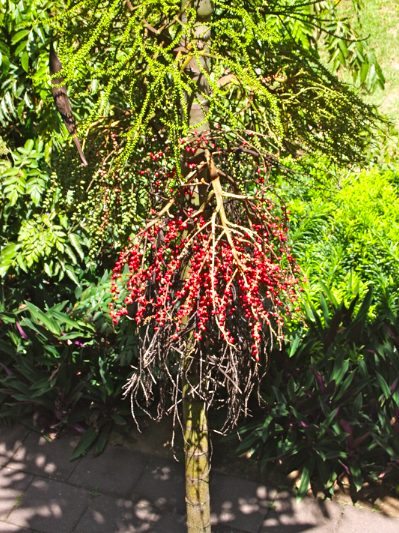
Tropical tree outside out balcony
Nudey Beach
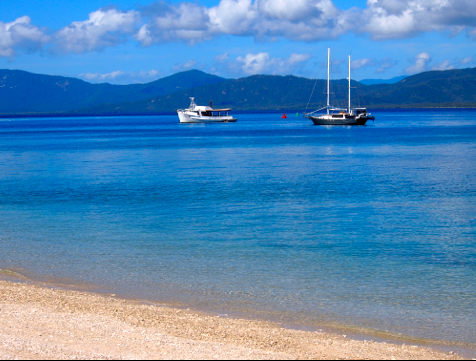
Sailboats anchored off Nudey Beach
Shortly after we arrived, we changed into bathing suits, picked up fins, snorkels, masks and stinger suits to protect against small poisonous jellyfish. We set out to spend the afternoon snorkeling on Nudey Beach a kilometer south of the resort. Before Fitzroy Island was developed, the island was popular with nude sunbathers.
The hike to Nudey Beach was over rocky path, navigating over boulders, and through thick vines, ferns, heavy underbrush, and tropical soft woods. A bit exotic and challenging, but worth the walk. This kept casual hikers away from the beach. When we arrived, only a handful of people on the beach of bleached coral and seashells. The coral and shells were smooth from rolling over on the sandy bottom of seas, eventually washing up onshore and being bleached by the sun. They ranged in size from marbles to clumps the size of your hand.
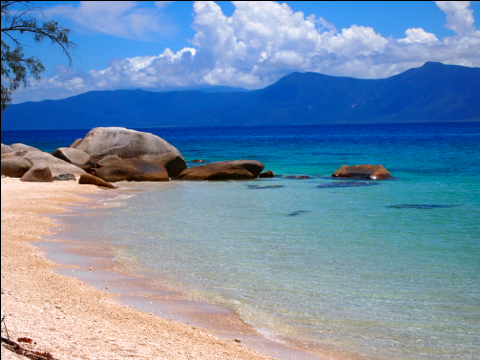
Nudey Beach
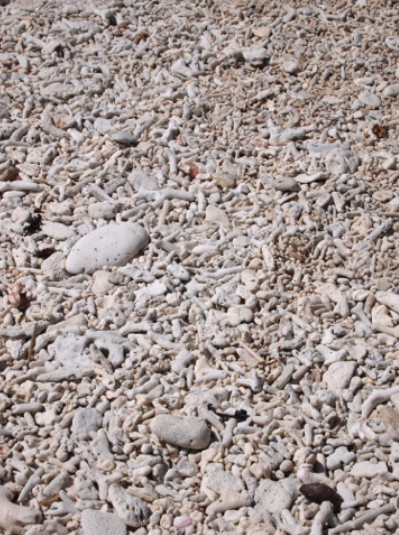
Bleached coral and seashells on Nudey beach
Snorkeling
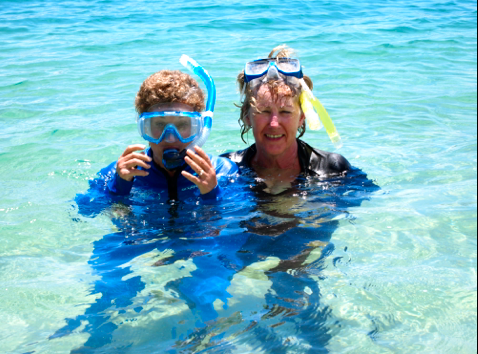
“Are there sharks here?”

Snorkeling babes
We walked from the coral beach into the shallows, swimming out about ten meters where the depth was about waist-high. At this point, you can see small coral formations. Swimming out further, larger coral formations rose from the sandy bottoms. The reefs were not as colorful as those we had seen on our dive trips, possibly because of the warm water close to shore. Climate change and global warming are killing reefs with warmer temperatures causing stress in the fragile coral ecology.
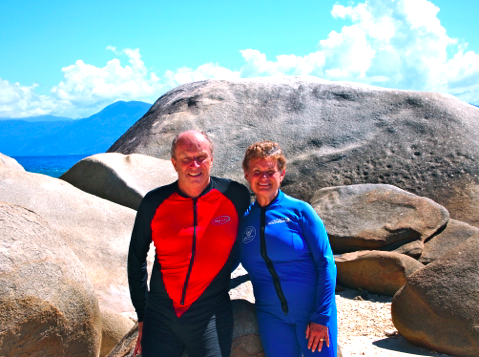
We love Fitzroy!
* * * * *
Next: Exotic wildlife on Fitzroy Island
In addition to this travel blog, I also write mysteries and romantic suspense novels available on Kindle, Nook,
and Smashwords which distributes to ereader devices. I hope you’ll consider reading and reviewing them. I’ll be publishing a new murder
mystery, REX ROYALE, in a few weeks. Let me know if you’d like to read a preview of the opening chapters.
jacklerickson@gmail.com








April 19, 2012
Cairns Lagoon
Cairns Lagoon
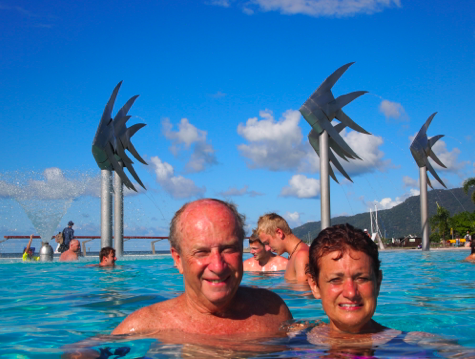
Sunburned tourists in Cairns lagoon
Cairns was occupied by Allied troops during World War II. Troops dredged the city’s harbor and left the beach muddy and dirty. It was the only beach we saw in Australia that didn’t have long stretches of sandy beach. A disappointment.
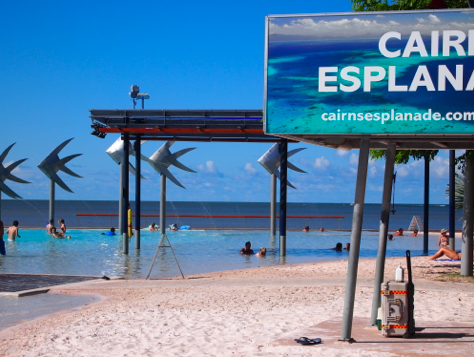
A sandy beach around the perimeter
But to give citizens a place to swim, they built a lagoon and added modern sculpture, lawns, palm trees, and benches. It wasn’t a real ‘beach,’ more like a pool at a resort.
It was so inviting, we swam in the lagoon several days, sometimes cooling off after walking around town, or just lounging in the afternoon. The water was pleasantly warm, the lagoon shallow, with a sandy beach, and only 5 feet deep.
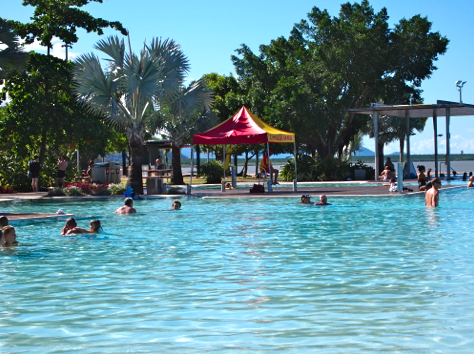
Resort -- or public pool?
All day, helicopters flew tourists out to the GBR from a helipad nearby. Sailboats, yachts, cruise ships, and dive boats sailed in the harbor and docked at Cairns marina.
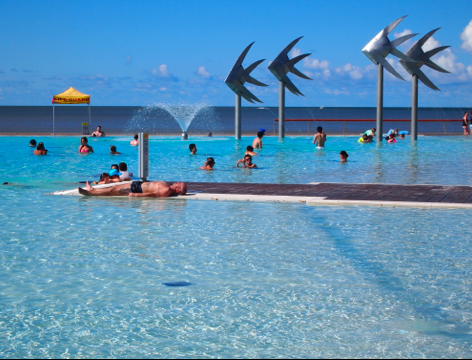
Cairns harbor in background
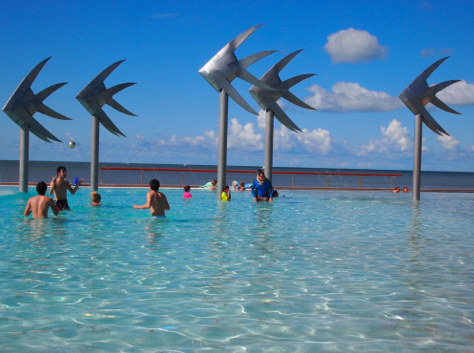
Sculptured fish
On hot and muggy afternoon, we’d walk to the lagoon, throw down a towel on the lawn, and walk in the sandy beach and dive into the warm water. So refreshing and clean, seagulls flying overhead, children splashing in the water, and a near cloudless sky overhead. A typical February ‘summer’ day in Cairns.
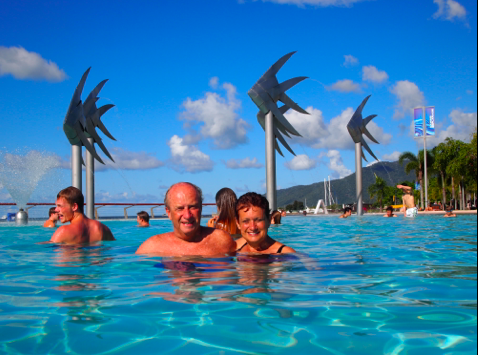
Sunburned and happy in the lagoon
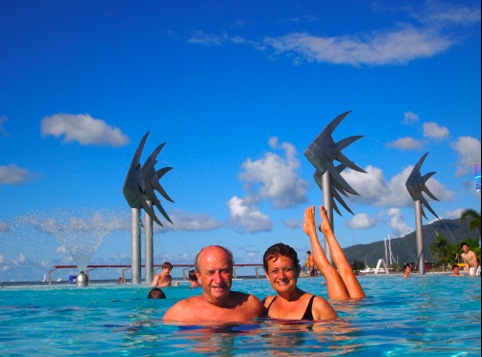
Look, a mermaid behind us!
Cairns lagoon was just one other reason we thought the town had so much charm; great ethnic restaurants, shaded parks, quiet streets, and beautiful views in all directions. We walked everywhere, from Heather’s Queensland style home (classic wooden one level house on stilts) into town, to the marina, shopping, and arranging dive trips.
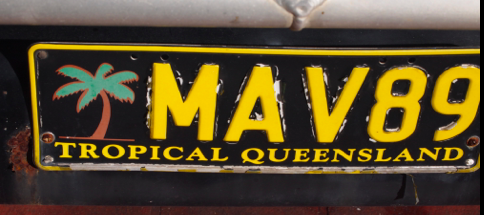
Queensland license plate
* * * * *
Next: Fitzroy Island
We welcome your comments to our travels Down Under. We want to hear from you!
In addition to this travel blog, I also write mysteries and romantic suspense novels available on Kindle, Nook,
and Smashwords which distributes to ereader devices. If you read books on ereaders, I hope you’ll consider
reading and reviewing them. I’ll be publishing a new murder mystery, REX ROYALE, in a few weeks. Let me
know if you’d like to read a preview of the opening chapters.
jacklerickson@gmail.com








Walkabout Cairns
Walkabout Cairns

Marilyn and Heather at Sunday farmers market
We spent two weeks in and around Cairns, which included two dive trips, and a four days in Herberton at Heather’s ‘tree house’ in the Atherton tablelands. The weather was hot and sticky, typical for tropical Queensland in the summer. But we enjoyed the weather, remembering all the ‘winters’ we’d spent in the U.S. with blizzards, freezing temperature, icy roads, and shoveling snow. We also enjoyed the tropical foliage, palm, banana, tree ferns,, magnolia, mangrove, and gum trees. As well as the exotic colorful birds and wildlife.
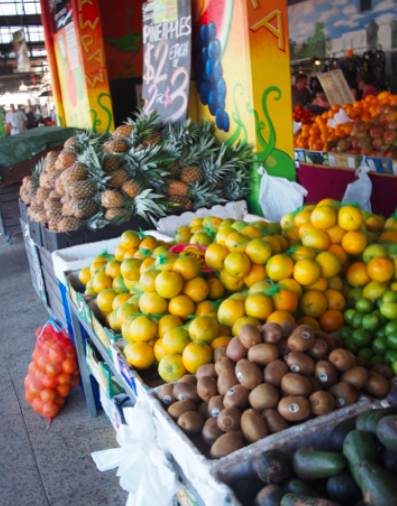
Fruit stalls
Cairns was casual than other towns we’d visited been in Australia. The coastal town is a major tourist destination for cruise ships and divers coming from around the world to experience the Great Barrier Reef. Australians also come here, traveling in vans, campers and RV’s, staying at the many vehicle camping places we saw.
Downtown Cairns was pedestrian friendly with wide sidewalks, parks, shade trees, benches, and cafe tables to enjoy people watching. Streets aren’t clogged with traffic and cross walks are well-marked and safe. Most buildings downtown are two or three stories, with only a few high-rise hotels and apartments, but no sky scrapers. It’s quite pleasant, letting tourists and walkers enjoy views of the mountains and forests west of town and the beautiful bay and marinas.
Sunday Market
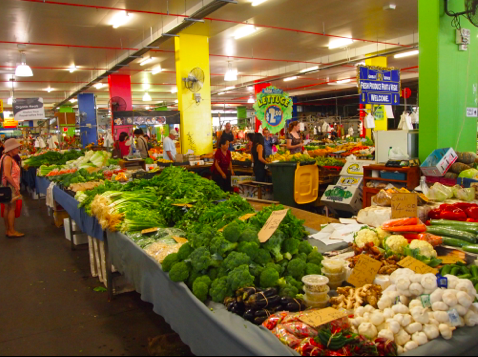
Vegetable stalls
Our last Sunday in Cairns we took a boat to Fitzroy Island to spend two days at a resort. On our way to the marina to board our boat, we walked through an open air farmer’s market in a walkway between two streets. Stalls were selling a variety of produce, crafts, souvenirs, and jewelry.
The most eye-appealing stalls were selling tropical fruits grown locally: coconuts, banana, mango, pineapple, papaya, grapes, and exotic fruits we hadn’t seen.
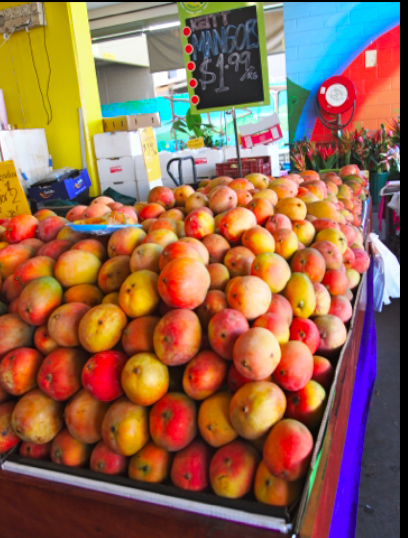
Juicy mangos
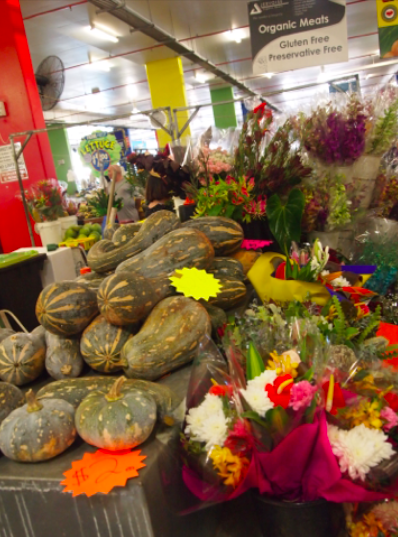
Tropical melons
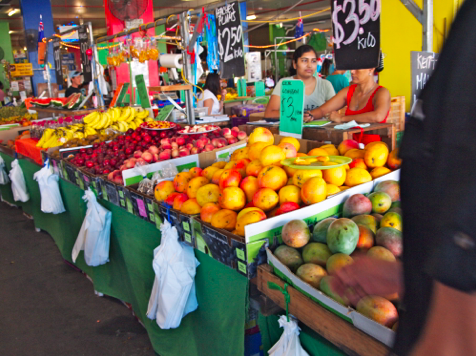
Tropical fruits for sale

Pineapples anyone?

Locally grown bananas - no Dole
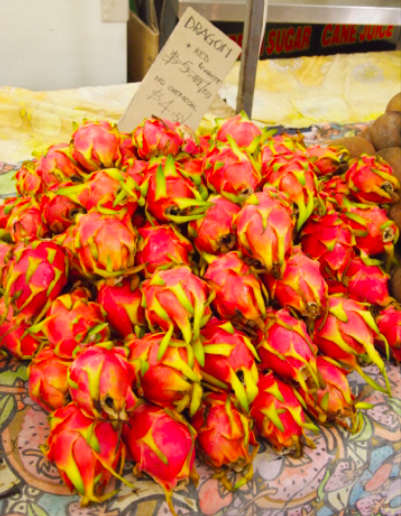
Dragon fruit that taste like kiwi and strawberries

Rambutan, a tropical fruit we hadn't seen before
Fabrics, clothes, crafts, and jewelry were attractively displayed.
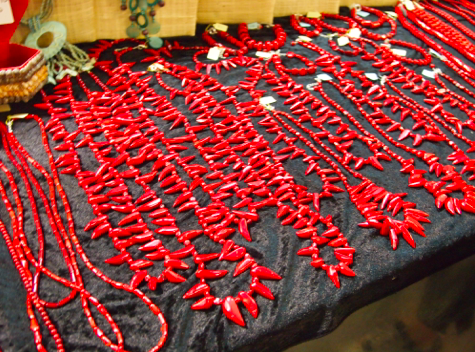
Fire coral necklaces
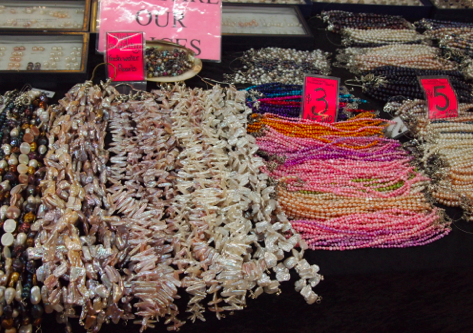
Coral colored necklaces
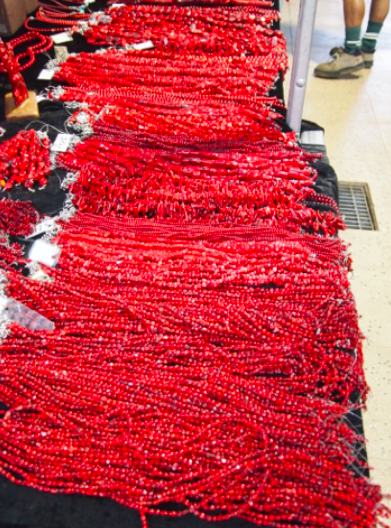
Fire coral necklaces
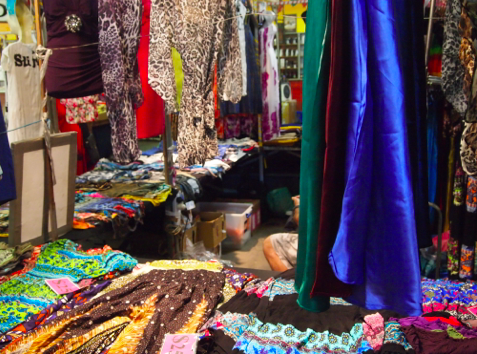
Tropical color fabrics
Tropical flowers were colorful.
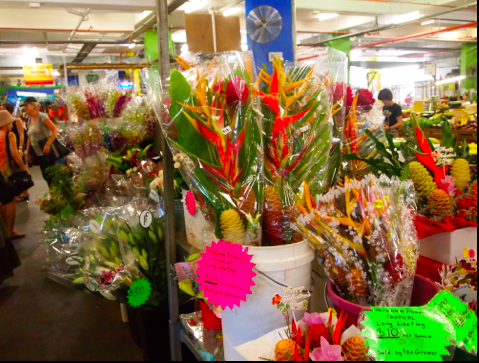
Bird of paradise flowers
Fruit bats
Walking through Cairns was a bit eerie; fruit bats the size of kittens flew over the city, roosted in tall trees, hanging upside town, fanning their bat wings, making raucous screeching noises. They looking somewhat menacing, but eat only fruit from area orchards and farms. All during the day, and especially in the late afternoon and early evening, the sky was filled with these bats which are called, ‘fur-headed flying foxes.’ They’re considered a pest by many for the messes they make on lawns and sidewalks, but they’re a protected species.
We heard there was a steep fine for anyone who interfered with the bats. But from the numbers we saw, they don’t need protection, they’ve adapted very well to their tropic paradise. We’d also seen the bats in Sydney and Melbourne in botanic gardens where they have plenty of trees to roost in, breed, and raise their young.
I have a video of the noisy ‘flying foxes’ roosting in the trees which I’ll post in the future. My still camera was acting up our last few days and the only pictures I took were with my video camera.
* * * * *
Next: Cairns lagoon
We welcome your comments to our travels Down Under. We want to hear from you!
In addition to this travel blog, I also write mysteries and romantic suspense novels available on Kindle, Nook,
and Smashwords which distributes to ereader devices. If you read books on ereaders, I hope you’ll consider
reading and reviewing them. I’ll be publishing a new murder mystery, REX ROYALE, in a few weeks. Let me
know if you’d like to read a preview of the opening chapters.
jacklerickson@gmail.com








April 17, 2012
Curtain Fig Tree and Termite Mounds
Curtain Fig Tree
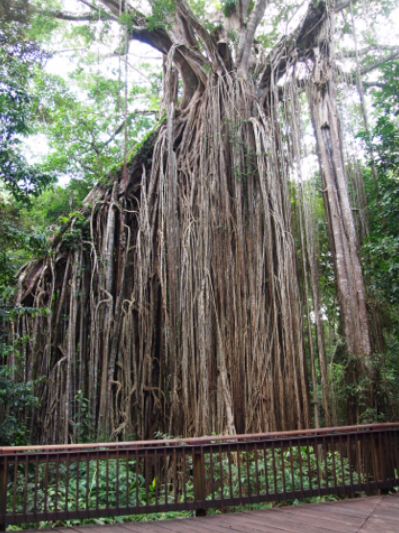
Curtain Fig Tree
The Atherton Tableland had many amazing natural settings; dormant volcanic lakes, rain forests, waterfalls, and a couple exotic oddities.
One of the most unusual oddities was a Curtain Fig Tree which we visited near the village of Yungabarra. The curtain fig is deep in the rainforest down a gravel road that led to a small national park. We walked from the parking lot into the rainforest on a wooden platform.
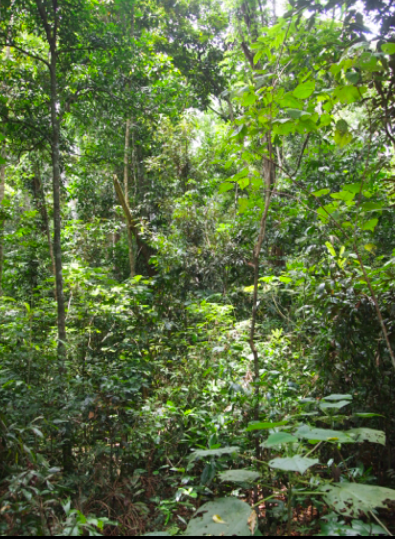
Rainforest near curtain fig tree
The curtain fig looked like a living waterfall with hundreds of roots streaming down from high in the canopy. It looked supernatural, from another planet or created in a laboratory. But it was a living tree, a strangler fig, fichus virens, which is an epiphyte, a plant that attaches to another species but does not use its sap to live.
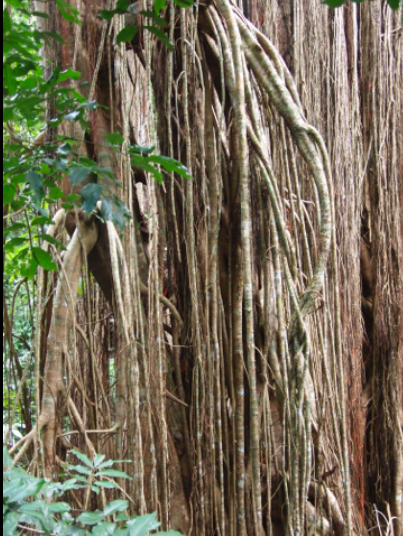
Aerial tree roots

Roots penetrate soil in heavy vegetation
A boardwalk around the tree allows you to examine its tangled aerial root system.
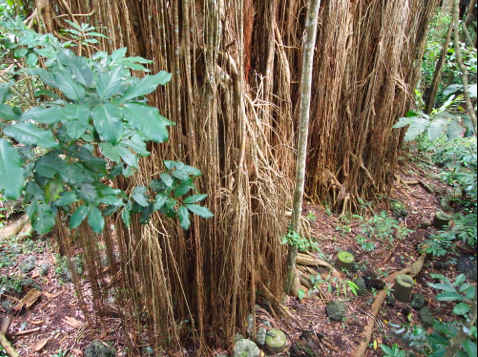
Roots of lace curtain tree
Strangler figs lean against a host tree and sends its roots into the soil. This curtain fig is more than 800 years old and 15 meters high. When it’s parent tree died, the curtain fig remained in place and continued to grow. The host tree can be seen, tangled in aerial roots at the top of the canopy. A sign detailed the history and botanical features of the tree.
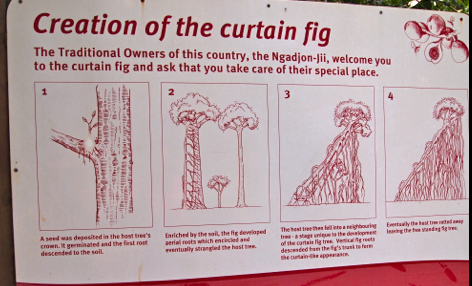
Park billboard explaining the growth of the curtain fig
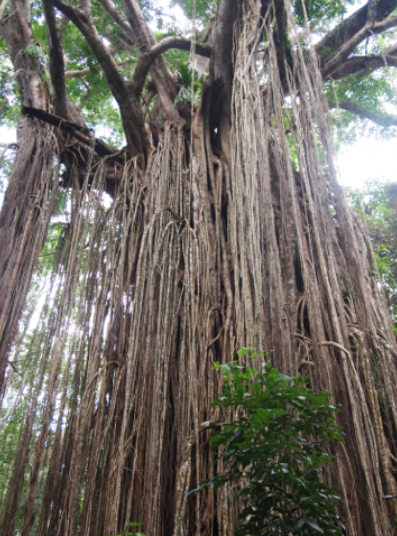
Dead host tree trunk high in canopy
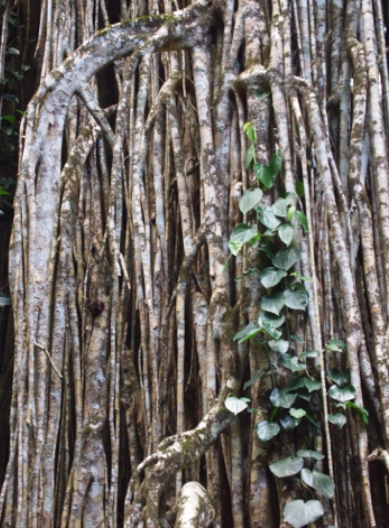
Closer view of roots
Termite Mounds
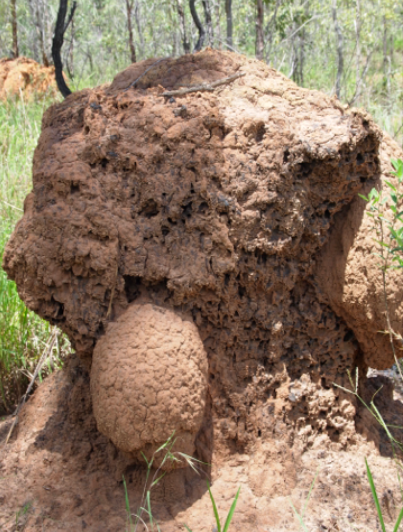
Termite mound
The day we returned to Cairns, we passed many reddish, sandy looking termite mounds visible through the rainforest. I was intrigued by the number, size, color, and unusual shapes of the mounds. I asked Heather to let me out on a side road and walked into the forest to get a few photos.
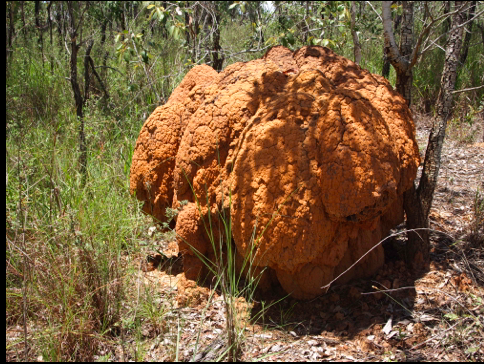
Interesting color . . . but a bit sinister
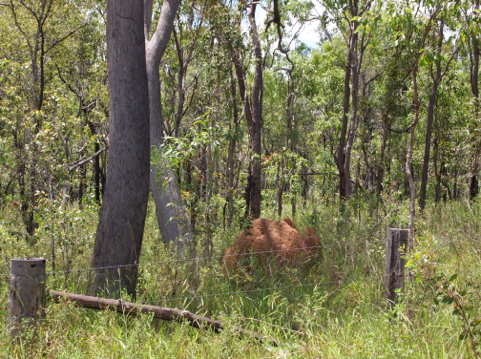
Somewhat camouflaged in the rainforest
What do you think, natural formation or something that fell off an alien spaceship? Whatever, you’d never want to camp near one of those things. Something creepy and slimy would like crawl out in the middle of the night and sneak into your tent.
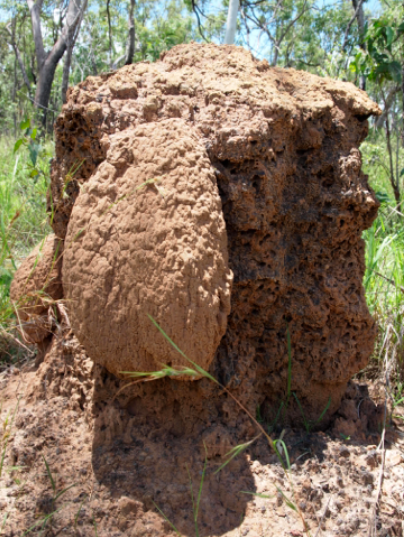
Something from another planet?
* * * * *
Next: Walkabout Cairns
Please share your comments on our travels Down Under. We want to hear from you!
In addition to this travel blog, I also write mysteries and romantic suspense novels available on Kindle, Nook,
and Smashwords which distributes to ereader devices.
If you read books on ereaders, I hope you’ll consider
reading and reviewing them. I’ll be publishing a new murder mystery, REX ROYALE, in a few weeks. Let me
know if you’d like to read a preview of the opening chapters.
jacklerickson@gmail.com








Herberton – the Atherton Tablelands
Herberton

Frangipani blossom at Heather's 'tree house'
Our friend, Heather, whom we stayed with in Cairns, has a vacation home in Herberton in the Atherton tablelands west of Cairns. She invited us to spend a few days in Herberton and experience the ‘wet tropics.’ The day after our GBR diving trip, we drove south a few miles out of Cairns then climbed the hills on narrow roads through canyons with amazing views along the way.
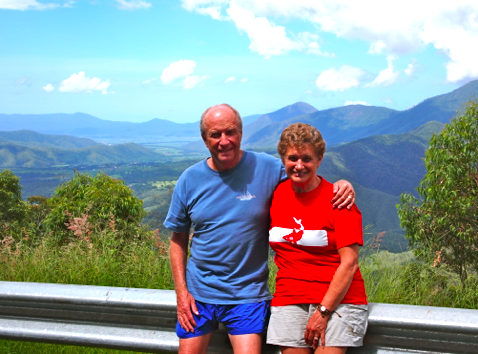
Viewpoint at Atherton tablelands
Lake Barrine
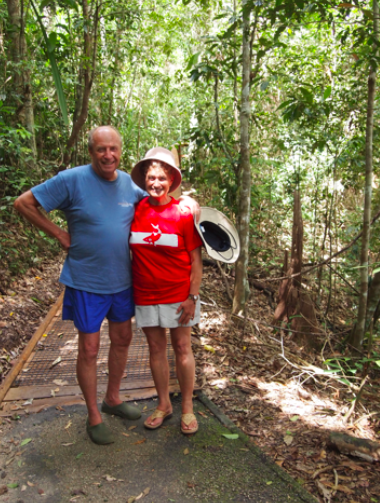
Hiking in the Rainforest at Lake Barrine
Heather had several sites in the Atherton tablelands she wanted us to visit. The first was Lake Barrine, where we hiked in the rainforest among giant Kauri trees, remnants of prehistoric times. While hiking, we ran into two Swedish young women who had been diving with us on the GBR. A nice coincidence, we chatted about our adventures in Australia, diving, and continued on our way, listening to the song birds, and looking over scenic Lake Barrine.
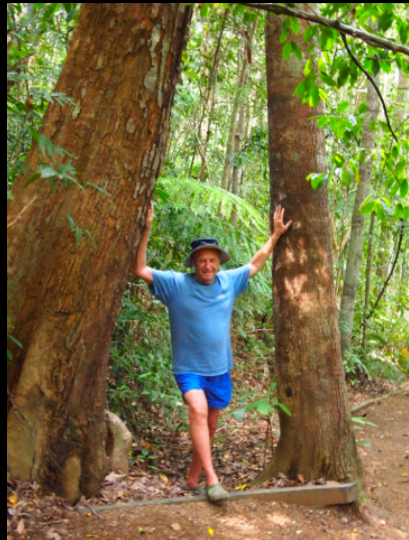
Lake Barrine rainforest
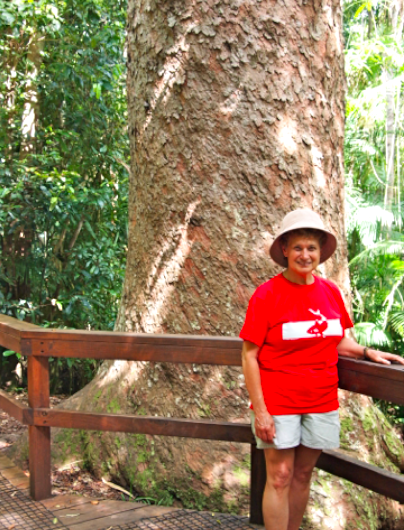
Lucy and giant Kauri tree
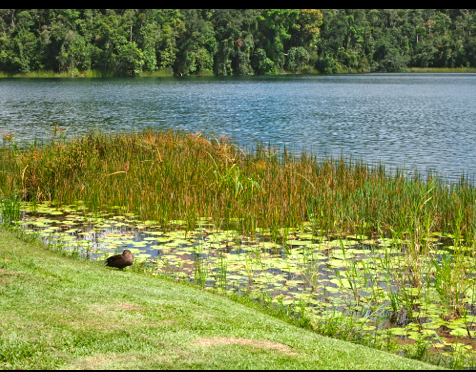
Lake Barrine
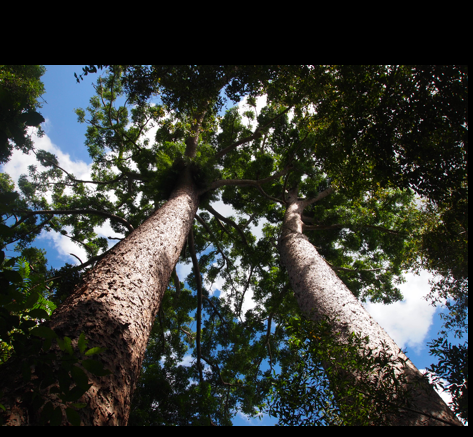
Ancient giant Kauri trees
Herberton
Passing through the charming town of Atherton, we arrived at Heather’s home, a former miner’s cottage. Herberton began as a tin mining town in 1880′s; it now has about 600 people, a copper mine instead of a tin mine, and restored building from its earlier mining era. Herberton resembles old, ’49′er gold mining towns in the foothills of California’s Sierra Nevada.
Herberton even boasts a camera spy museum with old cameras used in World War I.
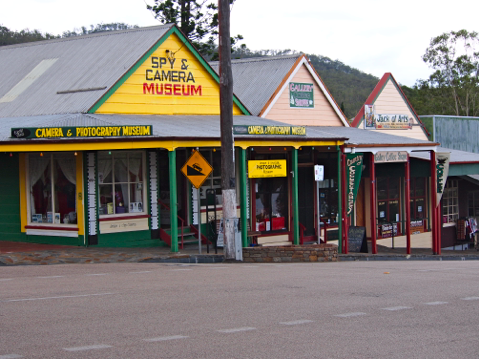
Herberton's spy camera museum
We walked into Herberton every day to shop, walk around, and enjoy the quaint town that was pleasant absent tourist traps you might find in old historic towns. One of our favorite places was the Op Shop (opportunity shops, or what we would call antiques). One afternoon, we stopped for a beer at the Royal Hotel bar and chatted up the locals, admiring old posters and photos from Herberton’s historic past.
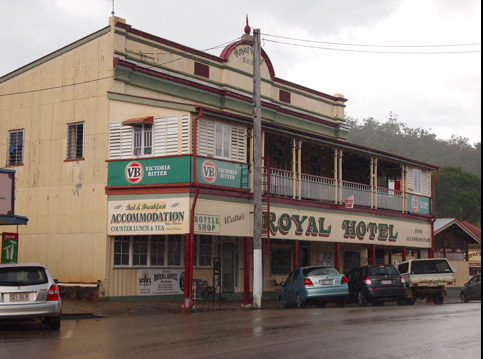
Royal Hotel in Herberton
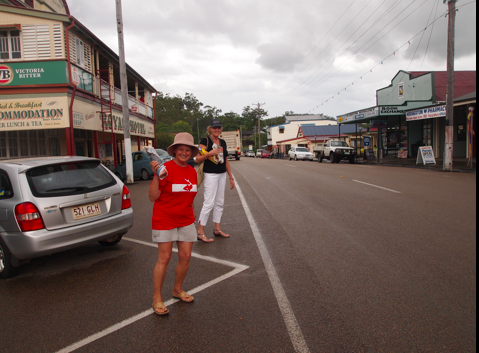
Marilyn and Heather on Herberton's 'main street'
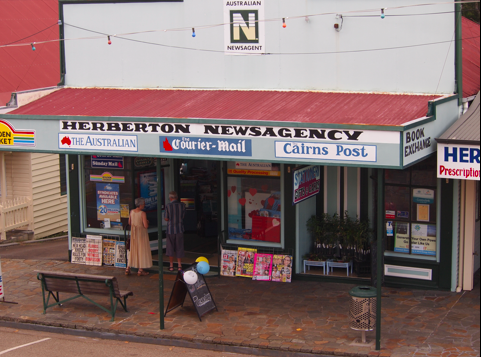
The local newsagent where we bought newspapers and used books
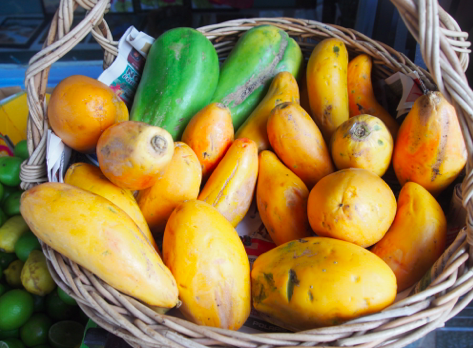
Papaya and mangos for sale in Herberton
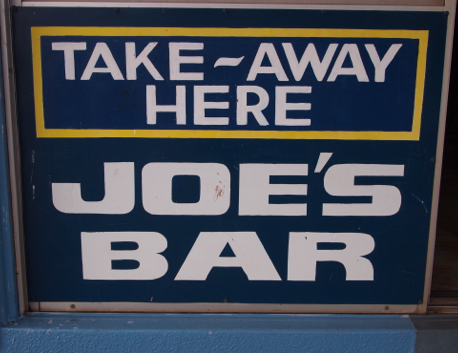
Local watering hole
Heather’s ‘tree house’
Herberton is a village with no stop lights, a library that shares space with the post office, a hotel with a pub, a bottle shop, sandwich shop, a bar, museum, and country homes that stretch back to jungle like forests. A stone bridge entering from the south crosses a rushing river.
Tourist information says that Herberton is one of the highest towns in the Atherton tablelands, rising about 1000 meters above sea level. It’s 120 kilometers from Cairns, with both roads traversing tight turns, steep hills, and spectacular views of the coastline.
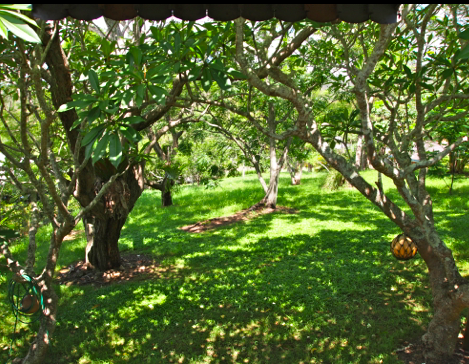
View from Heather's verandah
We fell in love with Heather’s home which we named her ‘tree house’ the moment we arrived. It’s located on a slight hillside surrounded by tropical trees; banana palms, mango, tree ferns, and frangipani which produce blossoms used in making leis.
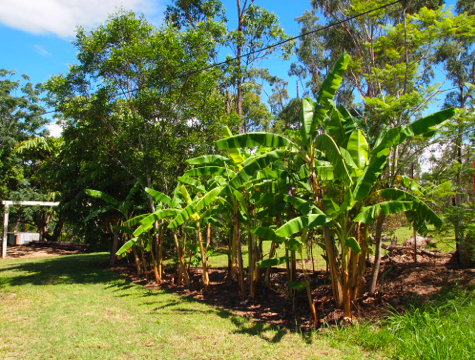
Banana palms at Heather's 'tree house'
Frangipani blossoms have a fruit like fragrance, delicate, sweet, and long-lasting. We picked blossoms off the grass and put them in trays with water. We enjoyed fragrant frangipani every time we ate on her verandah, enjoying the cool shade and the sounds of birds in her romantic tropical setting.
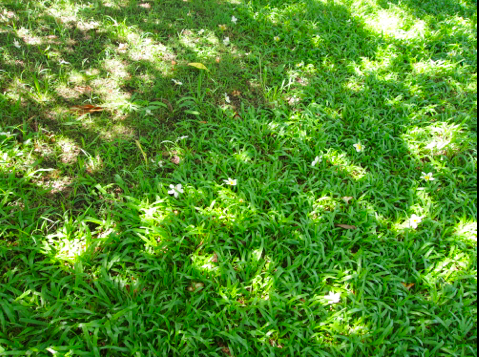
Frangipani blossoms in Heather's yard
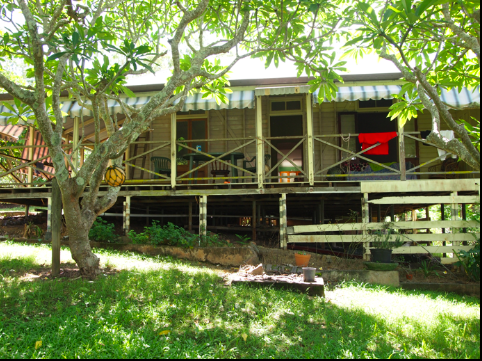
Veranda of Heather's home
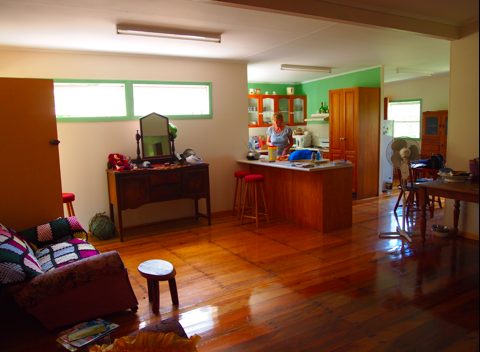
Heather's 'tree house' living room and kitchen
We ate breakfast, lunch, and dinner every day on Heather’s verandah, feeling like we were in a tropical paradise. In the afternoon, we sipped wine and talked about how much we were enjoying the setting, company, and wonderful birds.
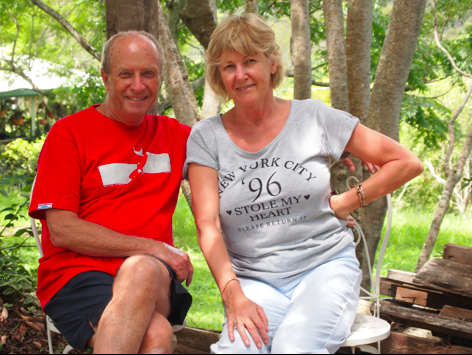
Jack and Heather on Heather's patio
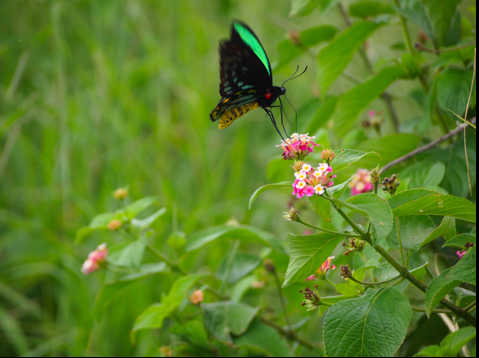
A butterfly in Heather's yard
Tropical birds
The trees around Heather’s ‘tree house’ were alive with tropical birds who flew around, cawing, chirping, and whistling all day long. Such a delight! I wandered in the yard, snapping photos of cockatoos, rainbow lorikeets, gallahs, parrots, and kookaburra. Kookaburra have a very distinctive, raucous cawing that rises in tone and volume, and finishes with a burst of laughter. Such a happy noise!
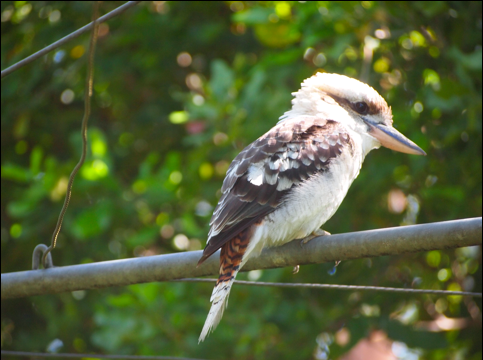
Chattering Kookaburra on a clothesline
If you’ve ever seen old ‘jungle’ movies, the sound you would have heard was made by kookaburra.
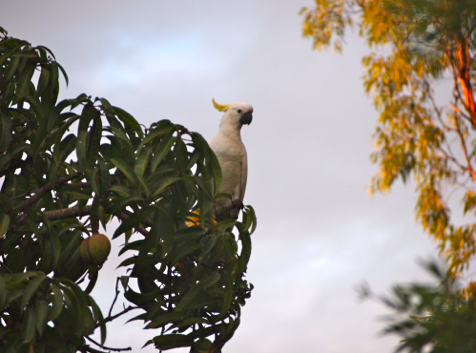
Sulpher-tipped cockatoo
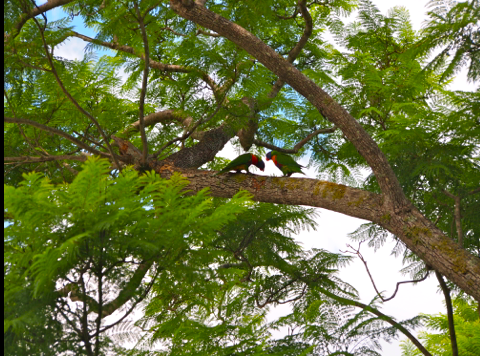
Parrots in Heather's trees
Our four days at Heather’s ‘tree house’ passed too quickly. In additional to relaxing and touring Herberton, we worked in her yard, combing up debris dropped by her trees, pruning pear and palm trees, and sweeping her patio. We felt so comfortable at her ‘tree house’ and were pleased that she invited us to return. We will. That’s a promise.
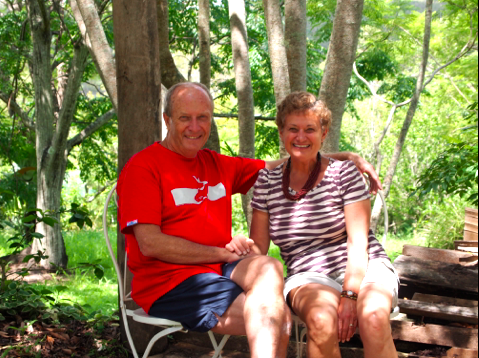
Relaxing on Heather's outdoor patio
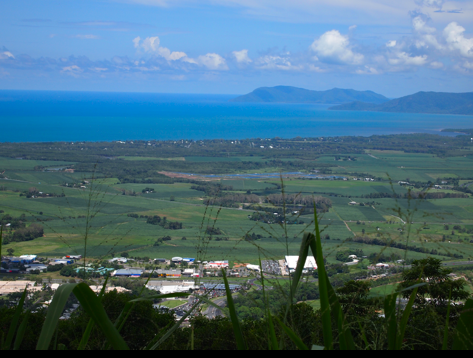
View of Cairns, Queenstown coastline from Atherton tablelands
* * * * *
Next: Curtain Fig Tree
We hope you’re enjoying our travels Down Under and will share your comments with us.
In addition to this travel blog, I also write mysteries and romantic suspense novels available on Kindle, Nook,
and Smashwords which distributes to ereader devices. If you read books on ereaders, I hope you’ll consider
reading and reviewing them. I’ll be publishing a new murder mystery, REX ROYALE, in the next few weeks. Let me
know if you’d like to read a preview of the opening chapters.
jacklerickson@gmail.com








Leaving the Reef
Leaving Great Barrier Reef
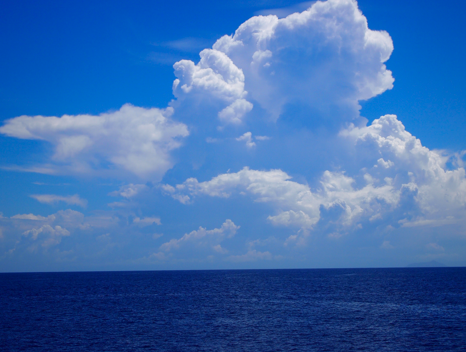
Morning on Flinn Reef
Night dive
Our night dive was spectacular.
We put on our gear — stinger suits, weight belts, BCD’s, tanks, regulators, fins and masks — under spot lights on the back of the boat and made our way to the duck board.
We had little glow sticks — pink and blue fluorescent tubes — attached to our regulators to follow other divers; blue for instructors, pink for divers. One by one, we plunged into the dark waters and followed glow sticks and torches of divers already in the water. Our hand torches were small plastic flashlights with cords around your wrists. We’d been cautioned not to shine them at other diver’s faces since the bright light would temporary blind them.
The reef was inky dark until we flashed torches around and saw glowing eyes peering at us from crevasses. The reef’s colors are muted at night. When a torch passed a school of tropical fish, all you could see was a flash of blue, silver, or yellow.
Sound seemed to be accented at night, possibly because our vision was limited. The aspiration of divers seemed louder at night as were the quirky squeaks and pings you hear underwater. Unfortunately, we weren’t able to take cameras on our night dive. The only piece of extra equipment we carried were hand torches.
Real life Alien
The eerie experience of diving at night reminded me of the movie Alien. One of the scariest parts of the movie was following the crew prowling through the dark cavernous ship, searching for the deadly alien creature while streams of water dripped from above and creaking noises and flickering lights amidst the dark shadows.
No doubt about it, the next time I see Alien, I’ll think back to swimming in the reef at night, a real life science fiction experience.
Early morning deep dive
Our third day began with an early morning deep dive, our third adventure dive to 30 meters. We started early so we could get in two more dives that morning before we departed the reef.
At 6:30 AM, we descended hand by hand down a tow line, then dropped it and let our weight belts carry us to the bottom, just shy of 30 meters. We cleared our ears several times as the pressure built.
Affects of deep water diving
On the bottom, we circled our instructor kneeling in the sand who was going to demonstrate the effects of deep diving. He first pulled out a collapsed soda bottle which had been crushed flat under heavy pressure.
Next he took a tomato from a plastic bag. On the surface, the tomato was red; at 30 meters, it was green. In our pre-dive talk, he explained that the sun’s UV rays are blocked when you descend in the ocean. Red is the first color that disappears, then yellow, orange, green, and blue. At the ocean’s depths, the only visible color is black.
The last deep water experiment was a demonstration on the brain’s ability to calculate. He did an exercise where he held up his fingers; we were to hold up fingers to reach the number 12. We all passed, but a couple were slower than the others.
Safety stops
Diving at greater depths puts more nitrogen into the bloodstream. In pre-dive lectures, we had been told the critical need to ascend slowly, making safety stops every two or three meters to let the nitrogen leave our bodies.
After our morning deep dive, we ascended slowly, watching our CBD’s computer which recorded our depth, time, and compass directions back to our boat. When we reached the tow line, we continued ascending slowly to the surface.
It had been an incredible early morning. Bobbing on the surface, all we could see were puffy white clouds in the blue sky, the sun rising above the horizon, waves rolling over the reef, and our boat.
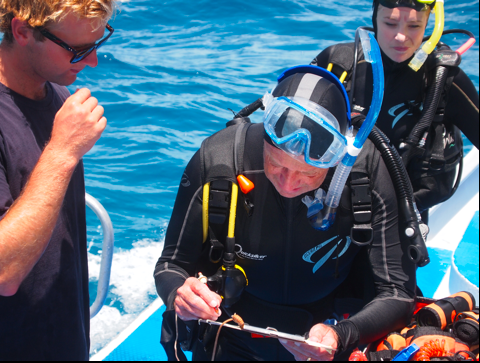
Logging return after deep dive

Thirty meters, thirty-five minutes, longest and deepest dive
Return to Cairns
After two nights and three busy days, our instructors untied anchor lines, retrieved the dinghy, and the captain fired up the engines. We were headed back to Cairns. We returned with mixed emotions, exhausted after nine dives, but exhilarated by living on the boat for three days, enjoying amazing tropical weather, experienced the incredible reef, and meeting interesting people from around the world.
But the wonders of the Great Barrier Reef were not over.
As we sailed back to Cairns, we saw amazing cloud formations. Summer in Queensland (December through March) is monsoon season. Storm clouds build over the mainland then drench the landscape in warm rains that come in the middle of the night or anytime during the day.
We’d already experienced monsoon rains in our week in Cairns. Watching the clouds building on our return, we knew we’d have heavy rains that evening.
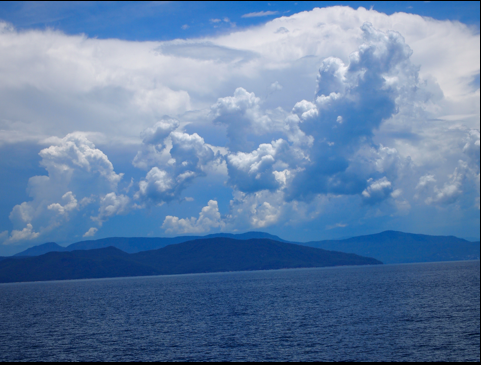
Monsoon clouds over Queensland coast
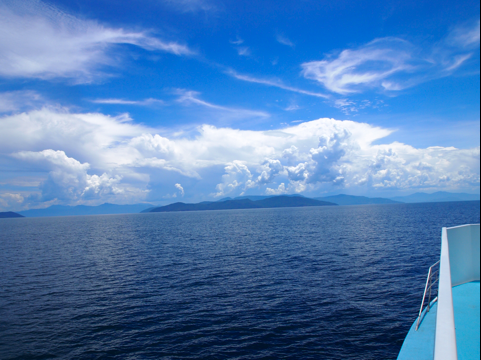
Approaching Cairns
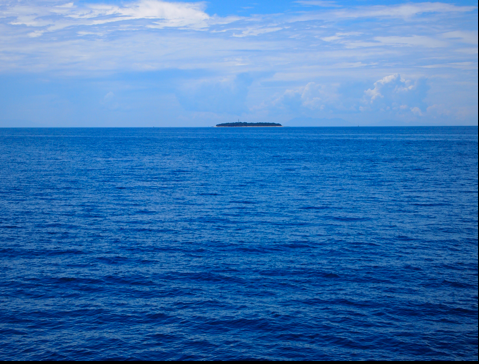
Green Island, closest island to Cairns, popular for day snorkeling excursions
Time to relax
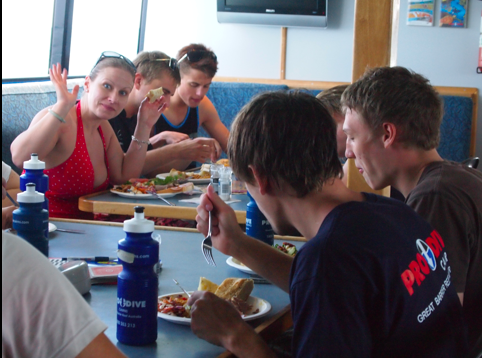
Lunch with dive buddies before our last dive
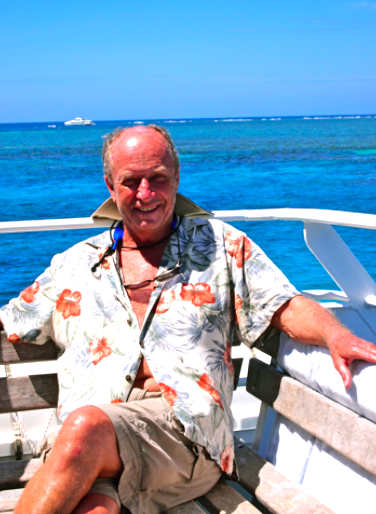
Relaxing on our return, tired, a little sunburned, but very happy
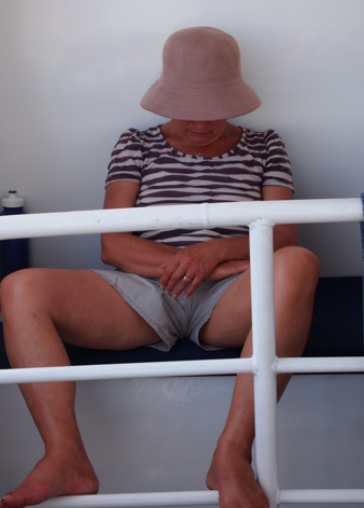
Siesta time
Breaking down our gear
Our instructors briefed us that we were responsible for getting our equipment cleaned, dismantled, and stored for the next divers. We washed our masks, fins, snorkel and stinger suits in tubs with a cleansing solution, dismantled regulator from tanks, washed CBD’s, and stored everything neatly. Clean, safely maintained equipment is critical for safe diving.
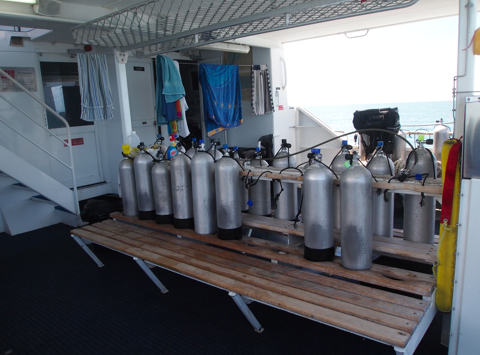
Empty tanks, waiting for next dive group
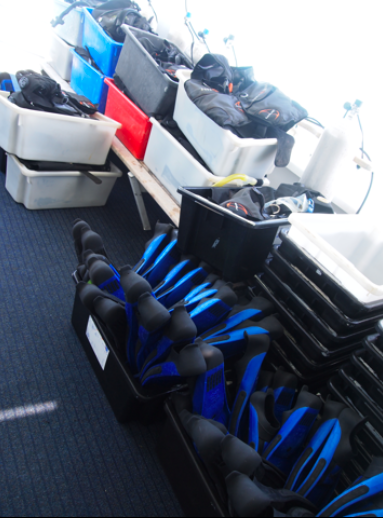
Fins, stinger suits, masks and snorkels stored for next group

Bathing suits drying on the rail, returning to Cairns
It was sad, knowing that our diving and snorkeling adventures were about over. But what we’d learned and experienced so much over three exhilarating days, meeting interesting Europeans, seeing the magnificent reef, and having the experienced Pro Dive team advising us.
I’ll also never forget the gentle feeling of the our boat bobbing at night while we slept.
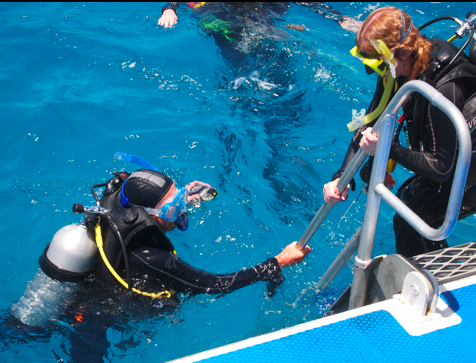
Boarding after last dive from amazing
turquoise water
* * * * *
Next: Herberton, Atherton tablelands, Queensland
Update: We arrived back in CA March 15 and have spent the last month reentering domestic life. We have a few more posts about Australia and will then start posting on New Zealand where we traveled from Auckland on the north island to Queenstown on the southwest of the south island. Lots of photos and tales of Kiwis and their beautiful country.
In addition to this travel blog, I also write mysteries and romantic suspense novels available on Kindle, Nook,
and Smashwords which distributes to ereader devices. If you read books on ereaders, I hope you’ll consider
reading and reviewing them. I’ll be publishing a new murder mystery, REX ROYALE, in the next few weeks. Let me
know if you’d like to read a preview of the opening chapters.
jacklerickson@gmail.com








March 13, 2012
Underwater photography on the Great Barrier Reef
Underwater Photography
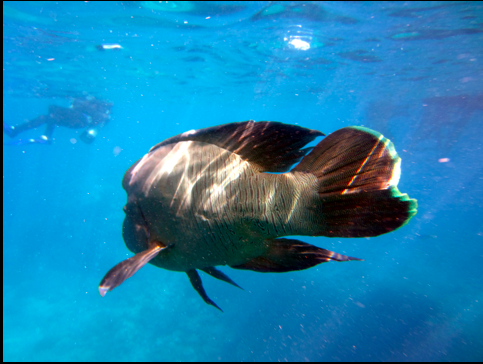
Sweet lips swimming below our boat as I entered the water
I made three dives with an underwater camera to take photos and videos of coral and tropical fish on the reef. One was with an instructor to get PADI certified for adventure diving.
The last dive on our third day I was able to shoot more freely, going where I wanted, accompanied by Raf who knew interesting formations and holes where fish would be.
It’s difficult to photograph when diving. Strong currents make it difficult to maintain balance and buoyancy holding a camera in both hands to focus and follow the fish. You see an interesting coral formation or fish swimming nearby, then move towards them, with only a few seconds to shoot. If you’re lucky, you get one or two good photos before the current sweeps you away or the fish swim by. It’s a bit of a challenge, but fun.
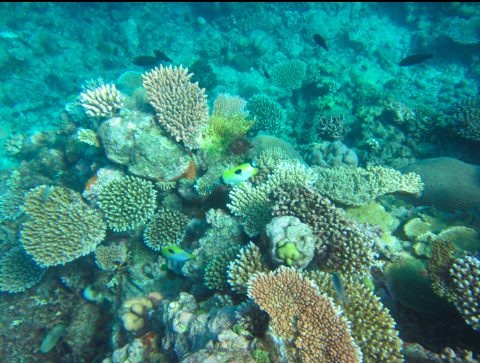
Colorful plate coral
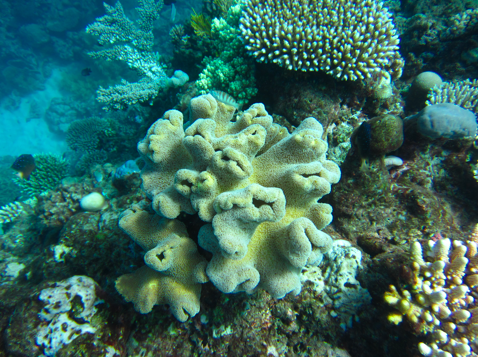
Waving coral
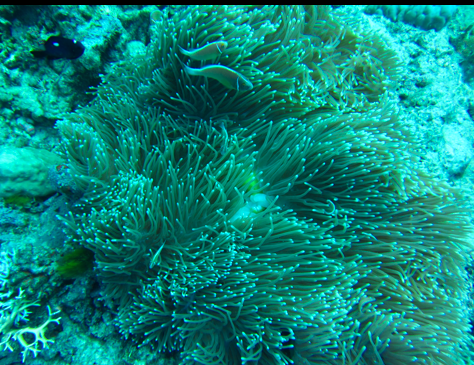
Fish swimming through anemone
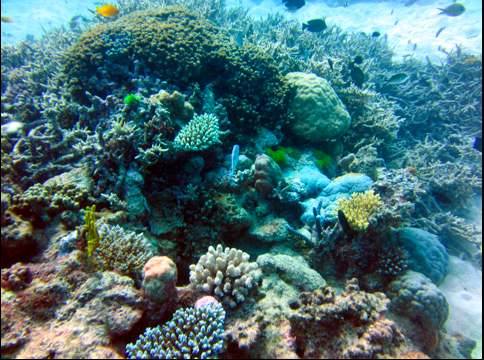
Technicolor coral
Small fish swam through anemone, seeking protection from predator fish.
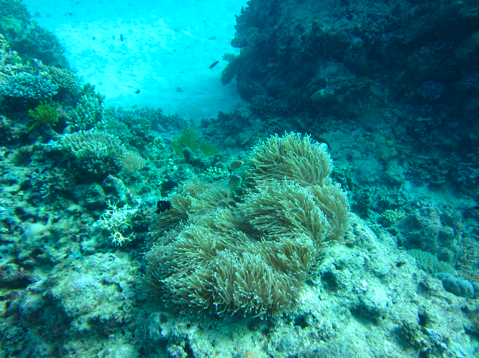
Anemone
Unusual jellyfish
One of the more unusual creatures I saw was a jellyfish that was a long cord of transparent film with a dot of living organism inside each cell.
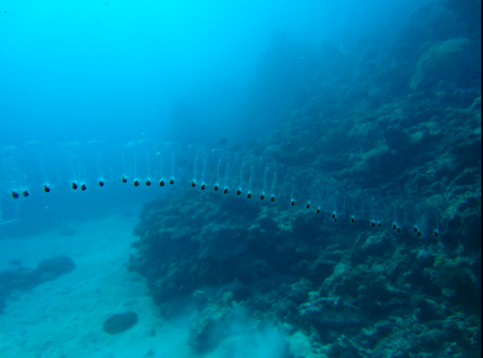
Unusual jellyfish, film of connected tissue with individual cells
Some living coral aren’t in the books we looked through. These were the only ones of this type I saw in three days. I hovered over the coral bank to get close enough for a couple of photos before currents pulled me away.
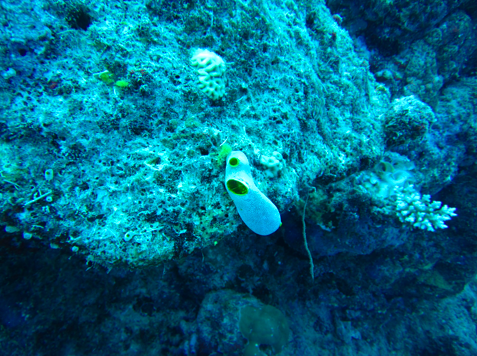
On the same coral formation
Plate coral were visible in many forms, textures, and colors.
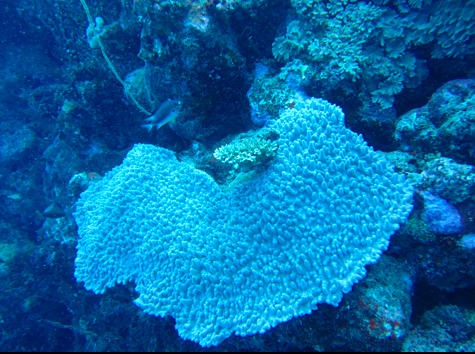
Plate coral attached to reef
On the wall of one reef, I spotted an unusual coral formation squeezed between coral walls. It looked like a fungus you’d find on a tree in a dark fores.
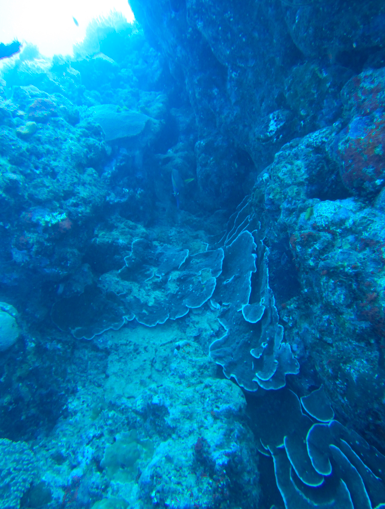
Fungus like coral between rocks
Elusive tropical fish
Sometimes a school of tropical fish would swim by, offering only a second or two to get a photo. Then they were out of range or disappear in the reef. It was fun, but a little frustrating, wanting to freeze time for that ‘perfect shot.’ Those are rare for the amateur.
The most difficult fish to film were schools of tiny silver, blue, yellow and red fish. They’d appear in the distance, sometimes swimming away, other times close enough to photograph. But hey swam away, took far for a good photo.
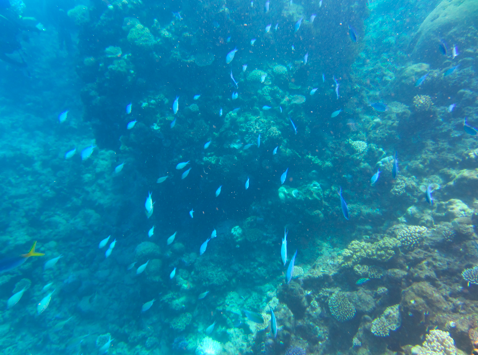
Beautiful turquoise fish, tiny, fast, elusive
On my adventure diving certification dive, my instructor pointed out a rare coronet fish seemingly suspended between coral formations. I couldn’t see it at firs;, my instructor swam closer and pointed until I saw him and got a quick photo. Later on the surface, my instructor said I was lucky to get the photo.

Coronet fish between rocks
Beautiful coral
Tropical fish are fun to follow and photograph, but many times my eye was drawn to beautiful coral, some very colorful and unusual in shape and texture.
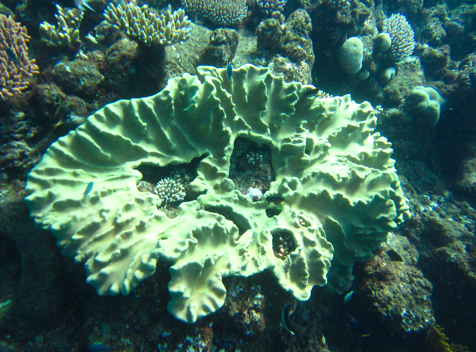
Mustard colored coral
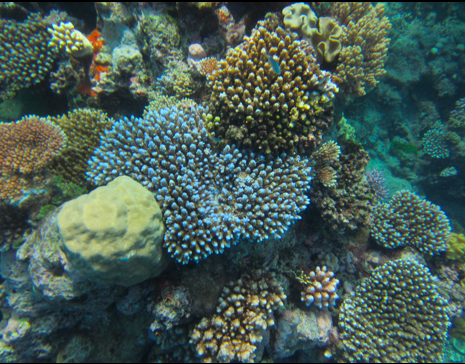
Blue pointed coral
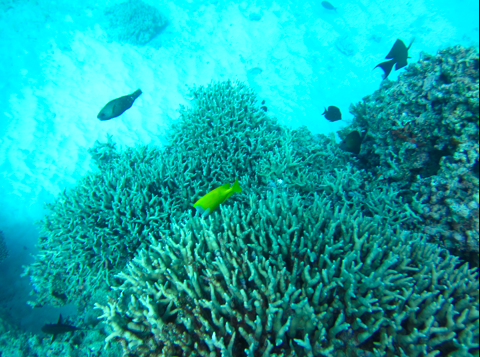
Coral, fish, and seabed
I was able to get a video of clown fish swimming in anemone. I’ll have more photos and videos to post in the future.
* * * * *
Next: Leaving the Great Barrier Reef
In addition to this travel blog, I write mysteries and romantic suspense novels available on Kindle, Nook
and Smashwords which distributes to ereader devices. If you read books on ereaders, I hope you’ll consider
reading and reviewing them. I’ll be publishing a new murder mystery, REX ROYALE, in the next few weeks. Let me
know if you’d like to read a preview of the opening chapters.
jacklerickson@gmail.com








March 12, 2012
Adventure Diving on the Great Barrier Reef
Adventure Diving
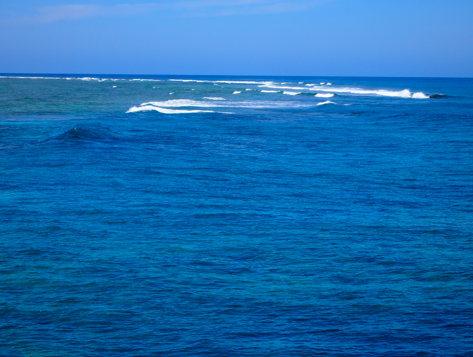
Flinn reef
The Professional Association of Dive Instructors (PADI) administers several certification programs for divers and dive companies. Divers begin with the basic open diver certification, classroom study, supervised instruction in a pool, and four open water dives with an instructor.
Once certified for open water diving, divers can enroll in advanced courses including adventure diving, advanced open water, wreck and rescue diving, several instructor levels all the way to become a certified master diver teaching courses and training divers.
After two dives our first afternoon and two morning dives the second day, we were certified for open water diving. Several in our group of 30 recently certified open divers enrolled in the adventure diving program which included a little classwork, reading through the AD book, and taking three additional dives: a deep water dive, night dive, and either nature or photography dive.
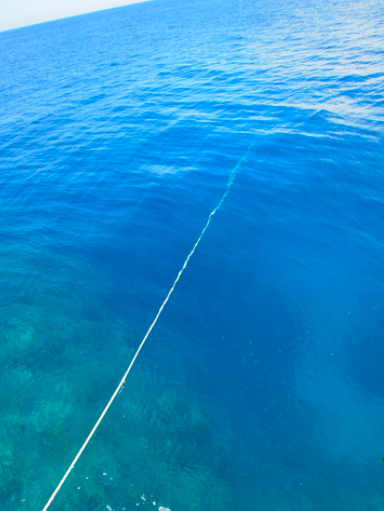
Anchor line off Flinn reef
After lunch, we all went up top for a briefing on features of Flinn reef where we had sailed the previous night. We had already been down twice that morning; two more dives were schedule, an afternoon photography dive followed by a night dive after dinner when. It’s very dark at night on the reef, with only the moon casting a light over the water. Anticipating diving into pitch black water made my skin tingle. I was more than a little anxious.
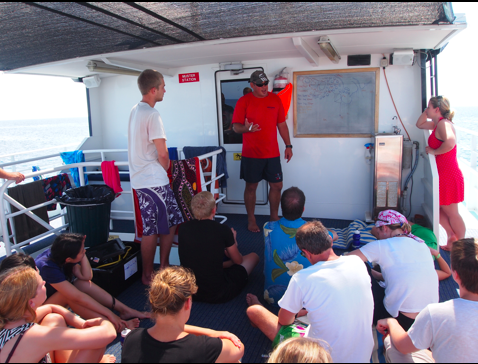
Oscar, master dive instructor, briefing us on Flinn reef for our adventure dives
Photography dive
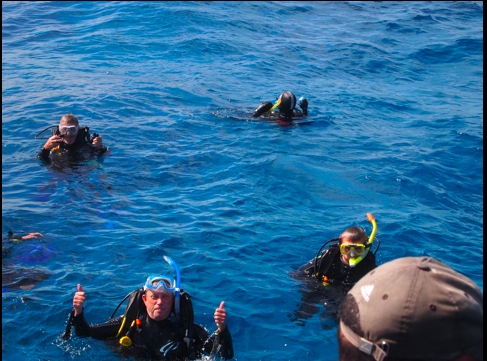
Everyone in the water for first adventure dive; I'm giving thumbs up signal in bottom left.
After the briefing, we put on our gear, teamed up with our dive buddy, and stepped off the duck board for our first adventure dive.
As soon as I descended, a hump-headed parrot fish cruised under our boat, staring at me with one glassy eye. I reached out to see if I could touch him (not supposed to do this!). He leisurely swam away and circled me.
He watched other divers descend and point at him, so close. We were all mesmerized, watching this strange-looking tropical fish who seemed as intrigued about us as we were about him. Or her.
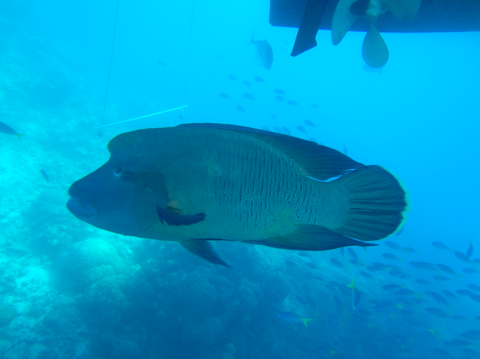
Hump-headed parrot fish, so close I could almost touch him. Or her. Hard to tell.
Our little group snapped photos and swam around the parrot fish to get it to face us head on. But it was too clever; it swam under the boat to follow other divers descending, leaving a trail of bubbles.
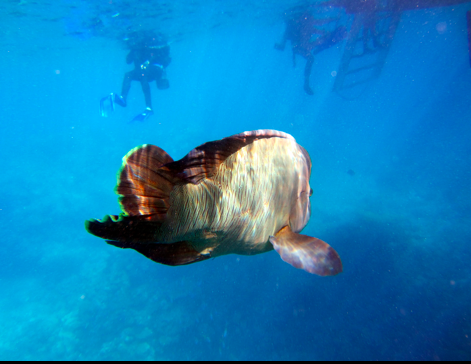
"I'm going to follow these other divers."
For the next 35 minutes, we swam around Flinn reef, looking for interesting coral and tropical fish to photograph, communicating with hand signals. Flinn reef was spectacular with many areas to explore, swimming between small ravines, along coral walls, with many crevices to peak into to spot tropical fish hiding. It was a real adventure, off on our own to explore this amazing place.
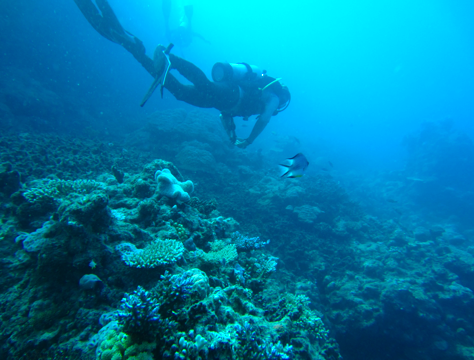
Let's go find a reef shark or sting ray to photograph
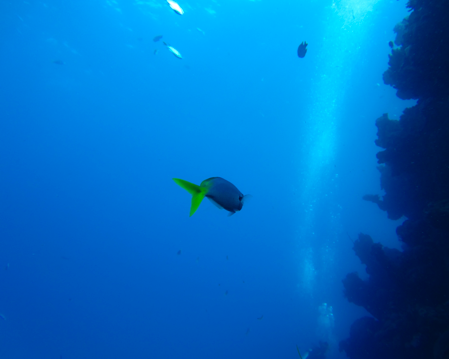
Angel fish swimming away
After about 35 minutes, we made our way back to our boat, giving thumbs up about getting photos and videos of the reef. I had snapped freely and was anxious to look at the photos and videos back on the boat (will post in next few blogs).
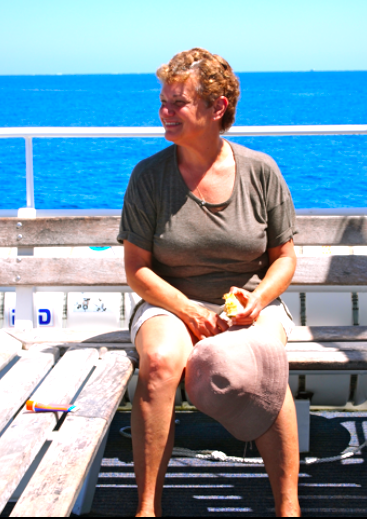
He's out there somewhere . . .
It’s difficult to see photos underwater; the monitor is cloudy, you’re maintaining buoyancy and swimming in currents holding a camera in both hands. Need to be on the deck, dry, and in natural light.
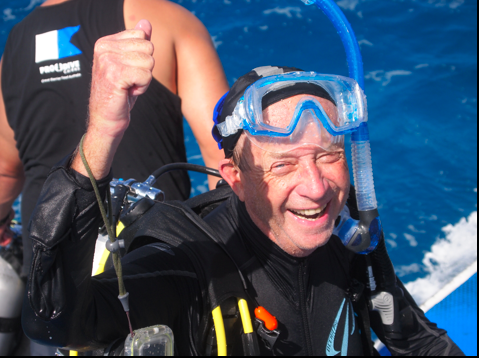
Aboard after photography dive; underwater camera on my wrist
Life on a dive boat
It’s not all study and hard work when you’re on a diving expedition. There’s time for hanging out, eating good food, talking to people from other countries, and looking out at the amazing reef a few miles from the Continental Shelf. Out on the edge, the shallow reef ends and the continent plunges 2000 feet to the Coral Sea bottom.
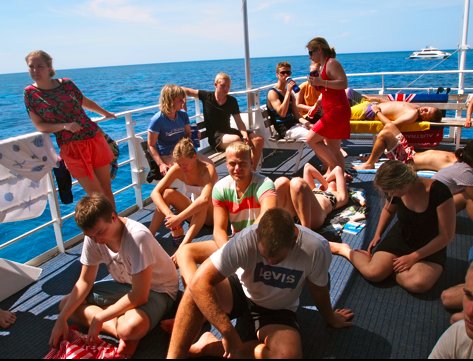
Relaxing on upper deck between dives
Pro Dive’s very capable team of instructors pitched in during 18 hour days, cleaning cabins, helping the cook, cleaning dishes, getting gear ready, tieing up and releasing anchor lines, filling tanks, and doing everything necessary to stay on schedule.
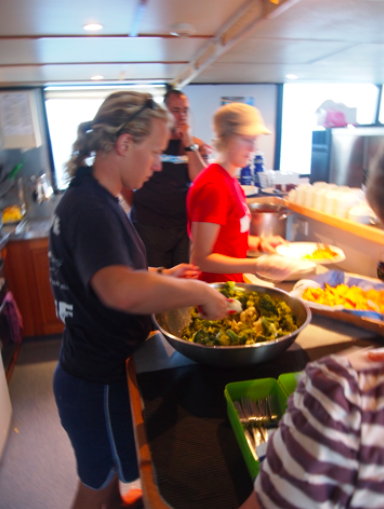
Dive instructors helping prepare dinner
Meals were healthy, abundant, served well, and deeply appreciated by all of us. You burn a lot of calories carrying 100 lb of gear, swimming in strong currents, and getting on and off the boat. You need a high carb diet; pasta, breads, salads, fruit, and lots of water.
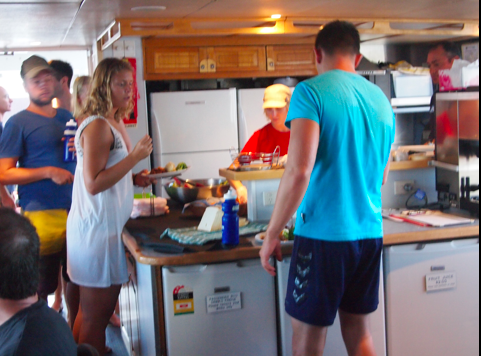
No need to repeat 'dinner's served' when hungry divers are around
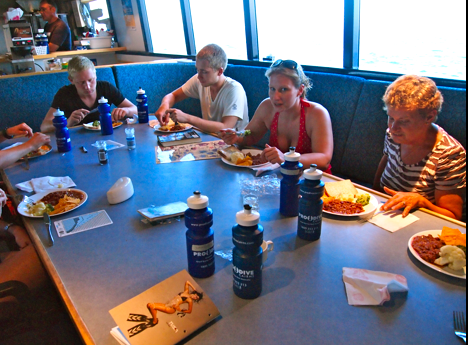
Lucy having dinner, our Swiss friend Anya on her right
During our busy day, Lucy had gone snorkeling with instructors and others. She made friends with several Europeans, including Anya from Zürich who hadn’t dived in more than five years. We shared stories with Anya about spending time in Zürich on our last couple trips to visit our daughter-in-law’s family who live on Lake Constance in southern Germany.
Night Dive
After dinner, we went into the cabin for a briefing about our night dive. Before the sun set, we walked out on the deck to watch a full moon in the eastern sky. The scene was like a painting, the colors so vivid and soothing. A memory to last a lifetime.
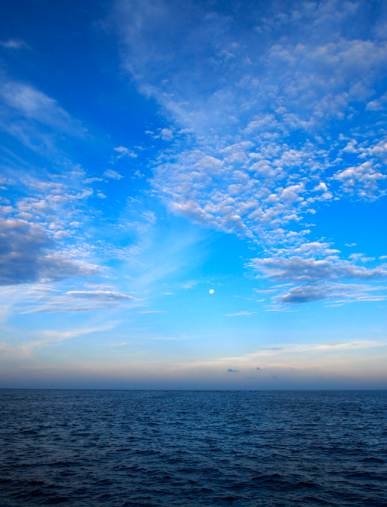
Warm summer evening on Great Barrier Reef
* * * * *
Next: Coral and tropical fish
In addition to this travel blog, I also write mysteries and romantic suspense novels available on Kindle, Nook,
and Smashwords which distributes to ereader devices. If you read books on ereaders, I hope you’ll consider
reading and writing a review. I’ll be publishing a new murder mystery, REX ROYALE, in a few weeks. Let me
know if you’d like to read a preview of the opening chapters.
jacklerickson@gmail.com








March 9, 2012
Great Barrier Reef
Great Barrier Reef

Satellite view of Great Barrier Reef
One of the natural wonders of the world is the Great Barrier Reef, a 2800 kilometer long group of 3000 reefs, quays, and 900 islands in the Coral Sea off the northeast Queensland coastline. More than 400 species of hard and soft coral inhabit the reef.
The Great Barrier Reef is the largest living organism in the world, visible from outer space. It became a World Heritage site in 1982 in recognition of its unique features as the largest reef in the world. Hundreds of sea and shore birds, sharks, dolphins, whales, sea turtles, sting rays, and tropical fish inhabit the reef, making it a highly desirable area for marine ecological study and divers.
When we were planning our winter Down Under, the Great Barrier Reef was high on the list of Australian destinations along with Alice Springs. Our week in the Red Center had been an exhilarating experience; we expected Cairns and the GBR to be the same. We weren’t disappointed
PADI
The day after we arrived in Cairns, I signed up for the five-day PADI diving course which included two days in the classroom and pool and three days diving off Cairns near the Continental Shelf.
Diving is regulated by Professional Divers Instructors Institute (PADI), a southern California-based organization that provides instructional material and issues credentials for divers who want to rent equipment, tanks, and regulators from approved dive shops around the world. Show your PADI card and you can get air in your tanks or rent equipment.
The local company offering the course and dive trips was Pro Dive which has a retail outlet in downtown Cairns and training center with offices, classrooms, and two pools about a mile away. Coincidently, the Pro Dive training center was just a few blocks from where we were staying with our friend, Heather.
Back to school
Early Friday morning, I woke up early, had a cup of coffee, piece of toast, kissed my wife goodbye, and walked to the Pro Dive training center to be a student again.
It had been decades since I had walked to morning class. I was a little giddy, anticipating meeting new classmates, listening to lectures, learning about scuba gear, and swimming. Not many educational experiences offer swimming as part of the curriculum!
Gap Year Classmates
The ‘student body’ was about thirty, mostly young Europeans traveling on their ‘gap year.’ We had met many ‘gap year’ travelers already in Australia. Some were college students taking time off between semesters; others were young professionals between jobs or careers.
Popular destinations for these young adventurers were Nepal, Thailand, South America, Australia and New Zealand. Australia offers one year visas for foreigners under the age of 30 to work in the country. We met several who worked a few months, then used their earnings to travel around the country.
Interestingly, we met few American ‘gap year’ travelers. With the high unemployment rate in the U.S — especially among younger workers and recent college graduates — I thought more young Americans would be traveling the world instead of posting resumes on line or going to networking mash-ups.
In the classroom
After a brief orientation led by a certified Dive Master, we were divided into classes of six and sent to classrooms or the pool. My classmates were five young men, three Swedes and two Germans; average age about 26. Add my age of 67, it would probably have been about 40!
Other classes had about the same composition, young Europeans with a couple Asian women. There were only two other Americans, an Asian couple from Los Angeles.
Class room instruction started with morning lectures, discussions, equipment demonstrations, videos, and tests. Our instructor was Raf from Konstanz, Switzerland, who had been a dive instructor in Mexico and the Caribbean. A good bloke, excellent teacher, and eager to help us all get certified.
In the afternoon after a quick lunch in our classrooms, we put on dive gear and got into the pool to test what we had learned in class. We changed breathing devices — regular and auxiliary regulators, snorkels — took off and replaced face masks underwater, removed and put back on CBD’s (wrap around jackets with sleeves for breathing hoses and inflation devices), and teamed with our ’dive buddy’ to practice emergency procedures including an emergency ascent.
My ‘dive buddy’ was Nicholas from Sweden, a nice fellow who was very technically oriented and a quick learner. He was especially helpful when it came time to read charts and graphs after we began diving on the reef.
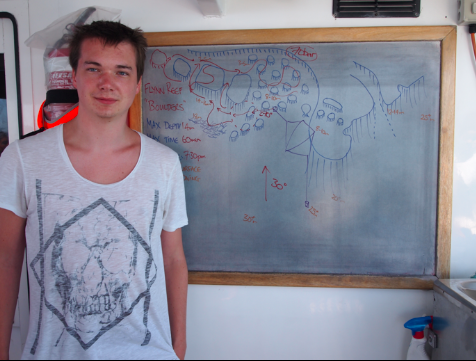
Nicholas, my Swedish 'dive buddy' on our dive boat in front of board with reef outline
Three Days on the GBR
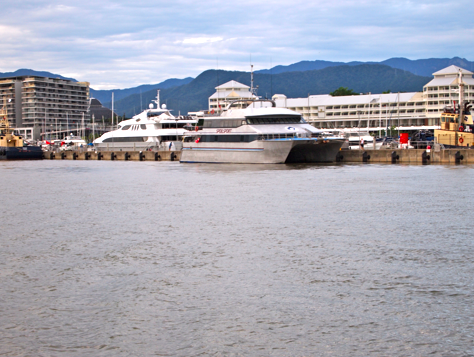
Leaving the dock at Cairns
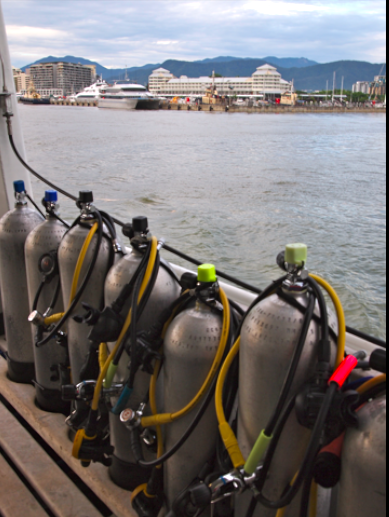
Scuba tanks and regulators
Milne Reef
After two days of classes, taking tests, familiarizing ourselves with our gear, we were ready for the real test — diving on the reef. On Sunday we boarded the Pro Div boat at 7:30 AM to sail an hour to Milne reef. After we arrived, we had a brief orientation about Milne reef, put on about 100 lb. of equipment and weight belt, did a safety check with our dive buddy, checked breathing devices and CBD’s, cleaned lens on our masks, and stepped down to the duck board on the stern. We put on fins and masks, logged in with the dive master who records each diver who enters the water, and waited in line.
When we were ready, we took a giant step off the duck board and plunged into the water. We inflated our CBD’s and waited for Raf to give us the signal to switch from snorkel to regulator. He gave us a thumbs up and we deflated our CBD’s and lined up on a tow line to descend hand over hand to the reef about four meters below.
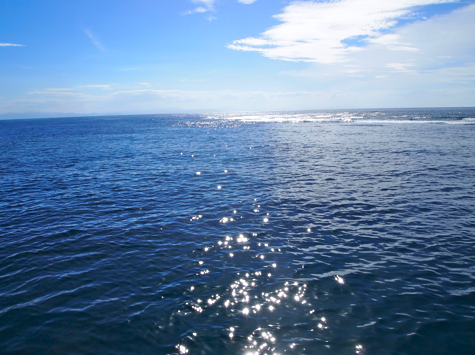
Milne reef, first dive site
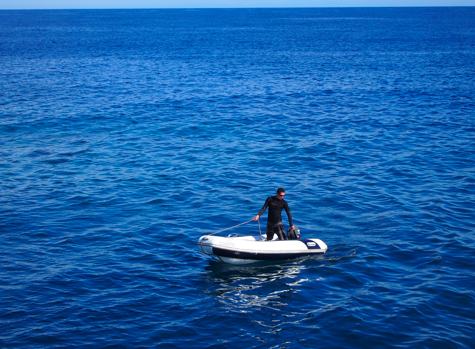
Raf tying boat lines to submerged anchor lines
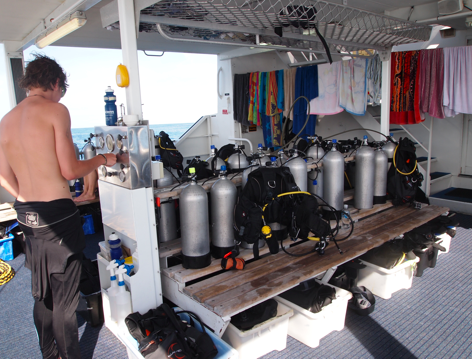
Filling scuba tanks
First dive
When we finished our first dive, we surfaced, took off gear, and went into the cabin to document our dive in our logbook. We recorded our depth and the time down; charts and graphs told us how long we had to wait before our next dive to minimize the danger of nitrogen in our bodies.
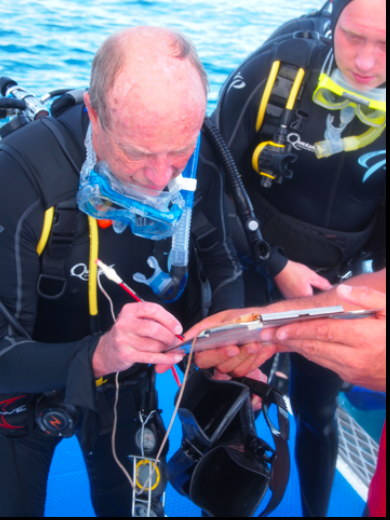
Logging time and depth of first dive
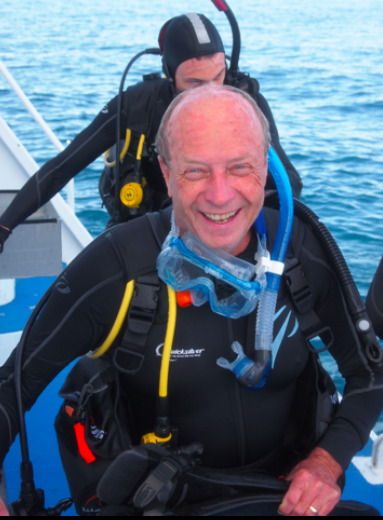
First GBR dive!
We had about an hour before our next dive. When we descended, we continued our underwater tasks, removing and replacing masks, communicating with our dive buddy, and practicing emergency procedures.
After our second dive, we returned to the cabin and recorded our dive information and discussed the next morning dives. After our second dive on day two, we would have four supervised dives and be certified by PADI as Open Water divers.
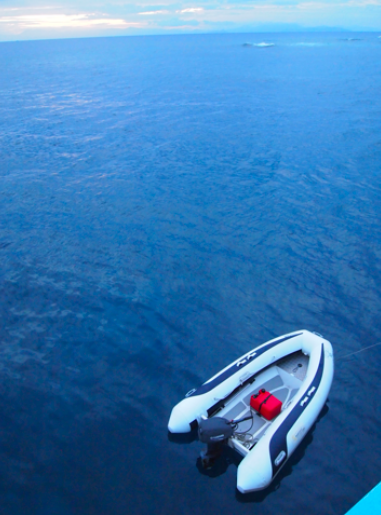
End of first day diving
First evening on the reef
We had a healthy dinner that night of salads, fruit, pasta and spent the early evening relaxing in the cabin, sharing dive stories, and listening to a lecture about night dives.
Onboard were certified divers taking a night dive that first evening. We listened to the master dive instructor lecture about the first night dive. After our second day, we would be certified and take our first night dive that evening.
It was a thrill to know that in less than 24 hours, we would be night diving, carrying ‘torches’ and have a fluorescent bulb attached to our regulators, looking for tropical fish on the reef.
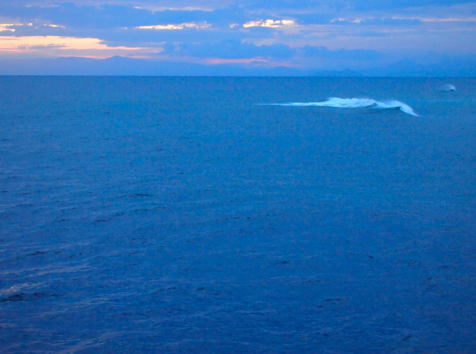
First evening on the reef
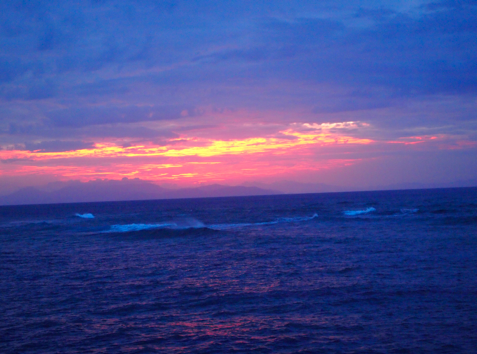
Sunset on the reef
* * * * *
Next: Coral and tropical fish on Great Barrier Reef
We hope you’re share your comments on our travels Down Under. We look forward to hearing from you.
In addition to this travel blog, I also write mysteries and romantic suspense novels available on Kindle, Nook,
and Smashwords which distributes to ereader devices. If you read books on ereaders, I hope you’ll consider
reading and reviewing them. I’ll be publishing a new murder mystery, REX ROYALE, in a few weeks. Let me
know if you’d like to read a preview of the opening chapters.
jacklerickson@gmail.com

